PinotFile: 7.19 June 5, 2009
|
Anderson Noir Valley Pinot (Pt II)This issue continues the alphabetical progression (H through Z) through all the major producers of Pinot Noir in the Anderson Valley and many producers outside the Anderson Valley that source grapes from within the Anderson Valley appellation. The Pinot Noirs from this region offer a multiplicity of styles, much like California generally, ranging from wines that are forward and readily drinkable upon release to ones that need years to uncover deep-seated complexities that lie within. Within stylistic differences, two constants are readily apparent. The wines can have lower alcohols than their counterparts from warmer growing areas within California, and the wines nearly always have a lively tug of acidity which makes for refreshing drinking and age ability. Because of the cool climate, the grapes are able to ripen slowly, achieving full phenolic ripeness without high sugars, while still retaining brisk acidity. The resulting Pinot Noirs are easy to love and recommend.
Handley Cellars Milla Handley is one of the few women in wine who is both the proprietor and winemaker at her own winery. Milla is the great-granddaughter of the owner of the Blitz-Weinhard Brewery in Portland, Oregon, but she realized early on that winemaking was more her suit than large-scale beer production. Raised in the San Francisco Bay area, she graduated from University California Davis with a degree in fermentation science, and studied under Richard Arrowood at Chateau St. Jean. In 1978, she moved to Anderson Valley with her husband, Rex S. McClellan, who went to work at Navarro. Meanwhile, Milla mentored under Jed Steele at Edmeades and made her first 250 cases of Chardonnay in her home basement in 1982. She welcomed the rural lifestyle of the Anderson Valley. Luckily, she was mechanically inclined, because when farm or winemaking equipment broke, there were few people to call on to fix it. Milla and her now deceased spouse acquired a 59-acre estate on Highway 128 in Philo, part of the historic Holmes Ranch and built Handley Cellars into a renowned winery producing 18,000 cases of several varieties annually. Planting of the estate vineyard began in 1986 and continued until 1999, now encompassing 30 acres of Pinot Noir (12.5 acres), Chardonnay and Gewürztraminer. The Handley Cellars Estate Vineyard was organically certified in 2005 by the California Certified Organic Farmers (CCOF) which is accredited by the USDA.
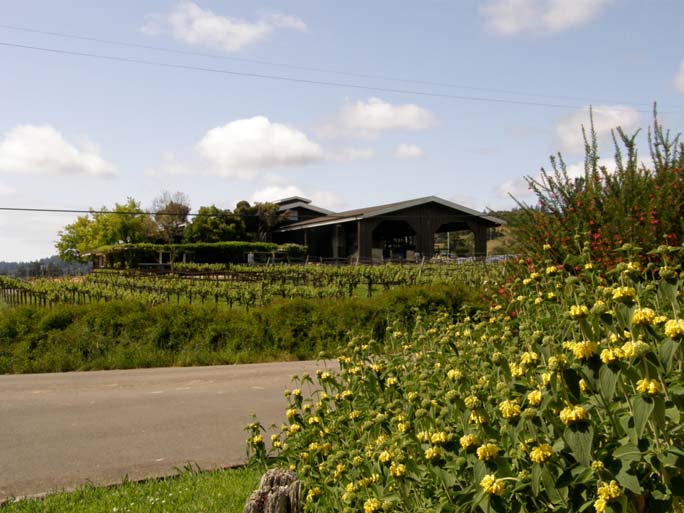 When I visited Milla at the recent Anderson Valley Pinot Noir Festival we hopped into her 4-wheel drive SUV and headed up Holmes Ranch Road for a view of the valley. We passed a number of family owned vineyards, including Esterlina Winery & Vineyards, until we reached the peak of the ridge. From here she pointed out the topography of the valley including Roederer’s expanse of vineyards in the distance and the Hendy Woods State Park to the West beyond the vineyards (see photo below). The park is named after the “Hendy Woods
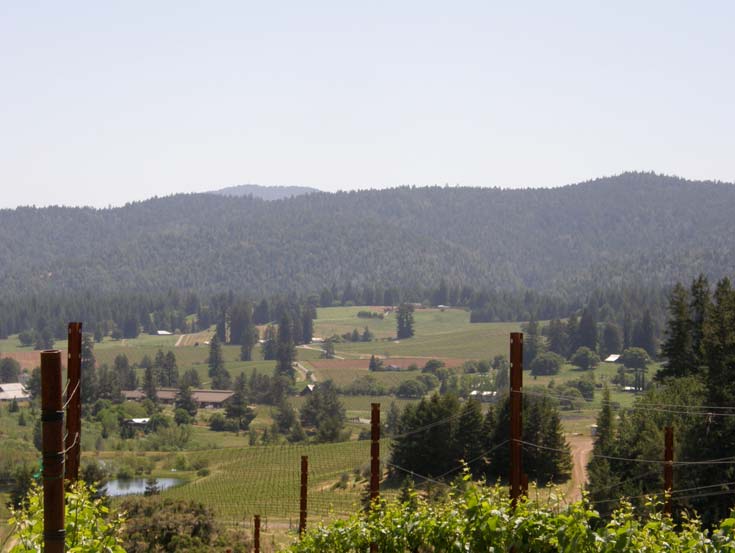 Hermit” who lived there in a fallen redwood stump. We continued to drive deeper into the eastern ridges where Milla lives in blissful isolation with her horse and dogs. Adjacent the house is the 7.5-acre RSM Vineyard named after her deceased husband. Milla planted this vineyard between 1999 and 2001 to Pinot Noir (Pommard, 115 and 667 clones) and Pinot Gris and hand tends this beautiful site. In 2005, she released her first vineyard-designate wine from this vineyard. As we head back down the road, Milla talks about the colorful
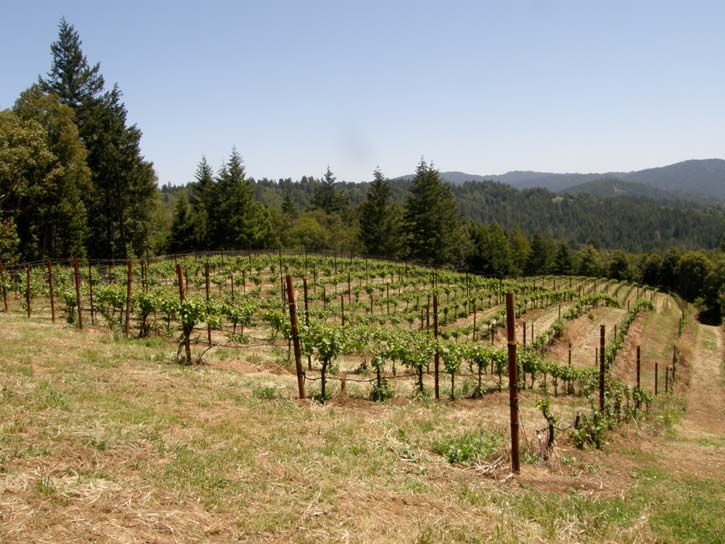
people who live in the area including feminist writer Alice Walker (The Color Purple) and Kary Mullis, who won
the Nobel Prize for the discovery of DNA fingerprinting. When we reach her charming tasting room filled with
her family’s collection of Oxacan, Indian and African folk art, it is buzzing with people sampling her wines. It
isn’t long before she is behind the bar, talking proudly about her wines. I manage to pull her away to the
garden courtyard adjacent the tasting room for an informative interview. Listen: “Interview with Milla Handley”
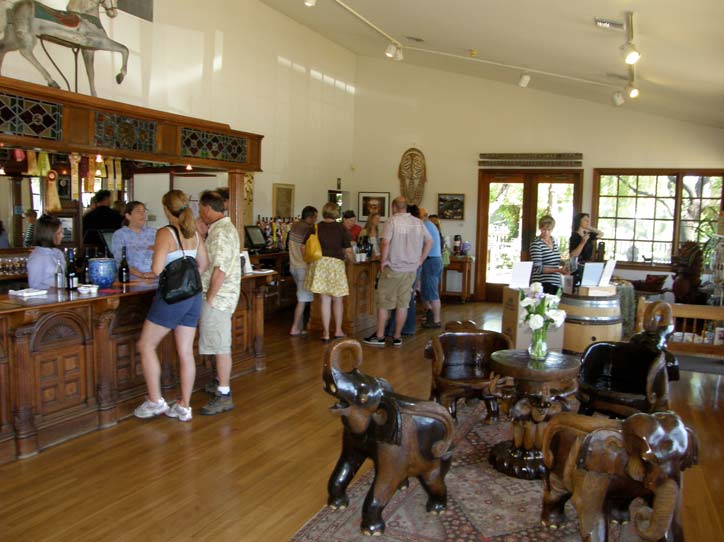
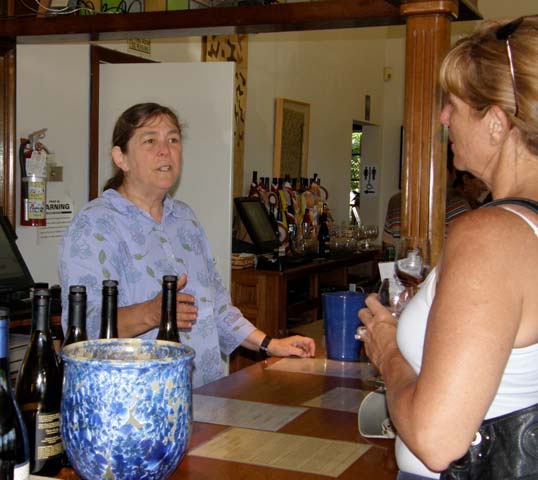 Milla produces an excellent sparkling Estate Brut and Brut Rosé to complement her still wine lineup which includes Chardonnay, Gewürztraminer, Pinot Blanc, Pinot Gris, Riesling, Sauvignon Blanc, Viognier, Syrah and Zinfandel. Some varieties are sourced from sustainably farmed vineyards in the Dry Creek Valley which Milla also owns and from other exceptional growers in the Anderson Valley. The distinctive Handley Cellars label was inspired by Milla’s love of the ancient tribal textiles crafted by African Kuba tribeswomen that, like wine, reflect both a complex and practical aesthetic. Milla is assisted in winemaking by Kristen Barnhisel who holds a Master’s degree in Enology from University California Davis. She has had an impressive winemaking background. She was the first American and the first woman to work harvest for Ruffino/Nozzole winery in Tuscany, Italy in 1998. The following year she worked harvest at South Africa’s Warwick Estate, and later had winemaking stints at Columbia Crest, Jordan Winery and Belvedere Vineyards before joining Handley Cellars in 2004. Handley Cellars wines are sold through the website at www.handleycellars.com and to a mailing list. There is also good distribution of Handley Cellars wines to restaurants and retail stores. The winery and tasting room address is 3151 Highway 128, Philo. The tasting room is open daily and each time you visit you will be welcomed by a friendly and familiar staff who have been at Handley Cellars for years. Tours are also available by phoning 707-895-3876 or 800-733-3151.
 2006 Handley Cellars Holmes Ranch Anderson Valley Pinot Noir 14.0% alc., 715 cases, $40. 46% Romani Vineyard, 37% RSM Vineyard, 15% Handley Estate and 2% other. 100% de-stemmed, lightly crushed, 40% whole berries, lightly pressed, inoculated fermentations, aged 9 months in 39% new French oak barrels. · Charming aromas of cherries, berries and tea leaves. Moderately rich fresh berry flavors with a hint of mocha and clove, soft tannins and a refreshingly dry finish. A perfect wine for the dinner table.
1998 Handley Cellars Anderson Valley Pinot Noir This wine was opened in both 750 ml and magnum format at the Open House on Sunday as part of the Anderson Valley Pinot Noir Festival. · The wine was still fresh with bright garnet color from both formats. Elegant and silky red fruits with no discernible tannins from the standard bottle. The Pinot Noir from the magnum format had more fruit intensity on the mid-palate with more retained structural tannins. Both wines were fine, but clearly the magnum wine was preferred and will age for a longer time.
Harmonique Bruce Conzelman, a successful real estate developer and long time Pinot Noir aficionado, teamed with veteran Anderson Valley winemaker Robert Klindt of Claudia Springs Winery to launch the Harmonique label in 2002. Rather than produce appellation or vineyard-designate Pinot Noirs, Conzelman chose to create two Pinot Noirs sourced from different vineyards and clones resulting in two distinctive wines. Delicacé is a feminine, finesse style while The Noble One is more opulent, structured and commanding. A third Pinot Noir, Elegancé, was introduced in 2005, sourced from old vines creating a complex, refined and aromatic wine with bright acidity. Two Chardonnays were introduced with the 2007 vintage. The wines have garnered many national and international medals and the winery received an award for “Best New Winery” at the Wine Appreciation Guild’s 2005 Wine Literary Award Press Tasting in San Francisco. Previous vintages have shown up on my annual “All American Pinot Noir” list. In January, 2007, the Conzelmans (Bruce’s spouse Moira handles all the marketing) acquired the 52-acre Christine Woods property and Rose Family Vineyard located across the street from Handley Cellars in Philo. Renamed the Conzelman Vineyard, some vines are now 29 years old. A winery is planned on the property.
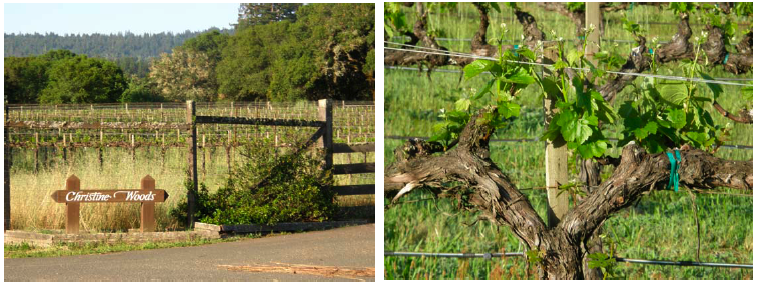 Winemaking is traditional in small lots in 1-ton fermenters, with hand picking, gentle de-stemming, native yeasts and non-intervention techniques. Typically, the Pinot Noirs are aged in 70% new French oak barrels for 19 months with one racking and blending of different vineyard and clone lots. The wines are then aged an additional 6 months before release (the current vintage release for Pinot Noir is 2005). The Harmonique wines are sold through a mailing list and on the website at www.harmoniquewine.com. An expanded and updated tasting room that is shared with Claudia Springs has opened next to the Floodgate Deli at 1810 Highway 128 at Highway marker 16 (call 800-937-1889 for hours). The Harmonique Chardonnays will be reviewed in an upcoming issue of the PinotFile.
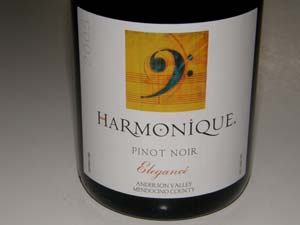 2005 Harmonique Elegancé Anderson Valley Pinot Noir 14.6% alc., 215 cases, $49.50. Inaugural vintage for this bottling. Harvested at 24.3º Brix. Sourced in small part from the Day Ranch Vineyard but primarily the Conzelman (formerly Rose Family) Vineyard. The Old Block (24 years old) of the Conzelman Vineyard consists of 4 acres of cordon pruned Martini clone. Yields were less than 2 tons per acre. · Darkest in color of the three 2005 Pinot Noirs. Hi-tone aromas of plums, raisins, sage and a hint of oak. Rich and ripe flavored dark fruits with notes of raisin, anise and Snicker’s bar, supple tannins, a silky and smooth texture, and a bright finish flush with tangerine peel. The oak is nicely integrated and the brisk acidity makes you reach for another sip.
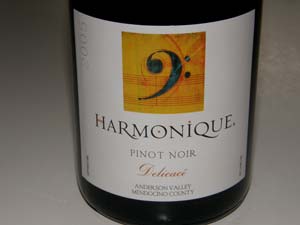 2005 Harmonique Delicacé Anderson Valley Pinot Noir 14.4% alc., 274 cases, $55. The grapes for this bottling in 2002-2004 came from primarily the Wiley Vineyard. In 2005 a frost event led to a loss of all the crop and grapes were then sourced from Ferrington Vineyard (Wädenswil clone) and Klindt Vineyard. I was really charmed by the 2002-2004 vintages of this wine and prefer them over this vintage. Harvested at 25.2º Brix. · Lightest in color of the 2005 Pinot Noirs. When you smell this wine, you want to dive in. Aromas of red berry tart, violets, musk and Moroccan spice. A delicate red fruit core with a hint of mocha and spice, noticeable dry tannins and a dry finish. The oak is commanding. The nose trumps the flavors in this wine.
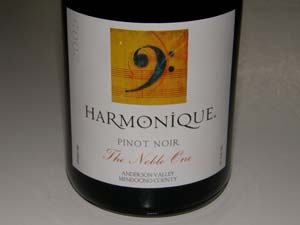 2005 Harmonique The Noble One Anderson Valley Pinot Noir 14.3% alc., 372 cases, $53. Primarily from Klindt Vineyard, clones 113, 115, 667 and Pommard, and a little Day Ranch. Harvested at 24.5º Brix. · Red and black fruits on the nose with an appealing hint of minerality, cola and herbs. Similar to Elegancé but not as ripely flavored. Well-perfumed dark fruit on the palate with a good bit of animale and earthiness. Impeccable harmony.
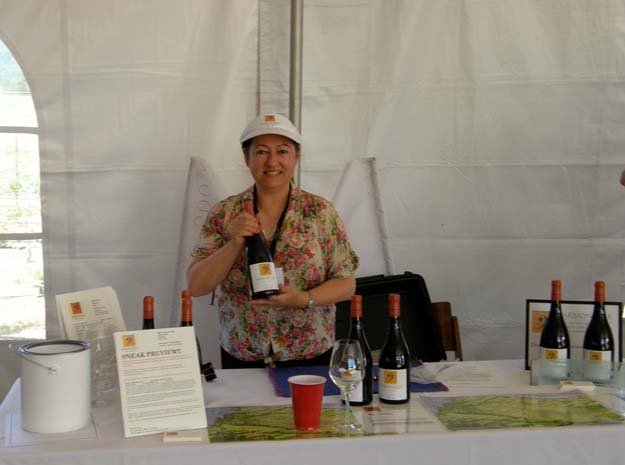 On Saturday night, following the Grand Tasting of Anderson Valley Pinot Noirs, several winemaker dinners are held in the Anderson Valley and in Mendocino as part of the Anderson Valley Pinot Noir Festival. I was lucky to attend the Harmonique Wine Dinner at the Mendocino Hotel in Mendocino. Featuring seasonal organic produce, local seafood and natural raised meats when possible, this hotel’s cuisine has reached a gourmand level under chef Joe Brown. Below is the menu just to tease you.
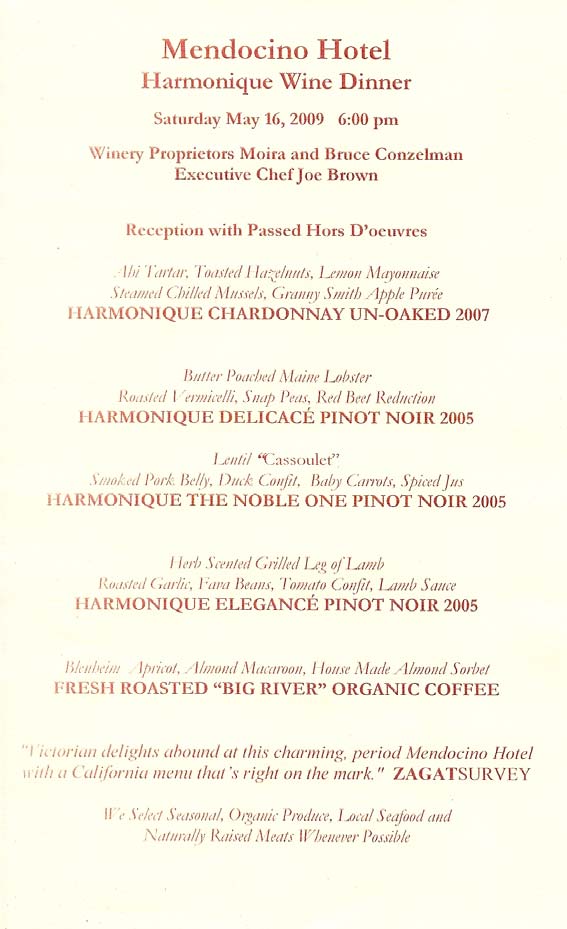
Harrington Wines Harrington is an urban winery, located in the produce district of San Francisco. Proprietor and winemaker Bryan Harrington is a Pinot Noir specialist whose wines have attracted my attention. His began making wine in his basement in San Francisco. He went on to take a number of classes from University California Davis before settling into his winery in San Francisco. He now crafts Pinot Noirs in small lots (less than 225 cases each) from five California appellations. The 2006 Wiley Vineyard Pinot Noir from Anderson Valley was a knockout and the 2007 vintage reviewed here is equally impressive. The wines are sold primarily through a mailing list at www.harringtonwine.com with limited restaurant and retail distribution. This is an outstanding artisan producer of Pinot Noir that deserves your attention. Photo below shows Bryan (left) and Ken Zinns pouring at the Anderson Valley Pinot Noir Festival.
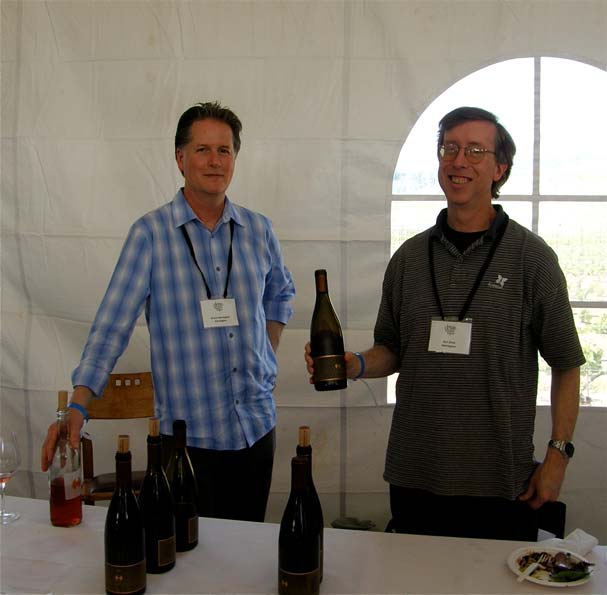
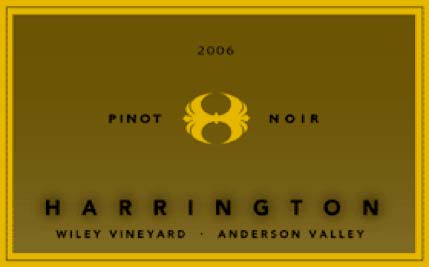 2007 Harrington Wiley Vineyard Anderson Valley Pinot Noir 14.0% alc., 227 cases, $40. Released April 2009. Wiley Vineyard is one of the westernmost Anderson Valley vineyards located in the deep end of the valley and often the last Pinot Noir vineyard harvested in the Anderson Valley. This wine is sourced from the vineyard’s 25-year-old Pommard block and some 777 clone from younger plantings. Harvested at 23.5º Brix. Aged 10 months in 25% new French oak barrels. · Alluring nose of black cherries with forest floor and stem spice. Very tasty dark berry and plum fruit with edible flower and chocolate overtones. Comforting in the mouth with soft tannins and bright acidity. Bottled in August of 2008 and now reaching a perfect drinking window.
2006 Harrington Wiley Vineyard Anderson Valley Pinot Noir 14.1% alc., $40. · Aromas of black cherries, newly sawed oak and a touch of barnyard are enticing. Black cherry and dark berry fruit flavors that are earth-kissed. Seamless with an impressive finish that seems to never end. This is a little-known vineyard gem and the wines I have sampled from the unique terroir have been stellar.
Husch Vineyards The current owners of Husch are the third generation of the Oswald family, Zac Robinson and Amanda Robinson Holstine. Vineyard manager Al White has been at Husch since 1973 and the current winemaker, Brad Holstine, has been on board since 2003. The photo below shows Brad Holstine (left) and Zac Robinson (right). Husch produces 21 different wines, all of which are estate bottled with total production reaching 45,000 cases annually. Besides its Anderson Valley vineyards, Husch farms the 128-acre La Ribera Ranch in Ukiah Valley which is planted to Cabernet Sauvignon, Zinfandel, Sauvignon Blanc, Chardonnay and Chenin Blanc. Three Pinot Noirs are offered: a value-priced Anderson Valley blend, an Anderson Valley Reserve, and the Knoll Vineyard (with plantings dating to 1968) single-vineyard bottling. Note the receipt below from Wente Brothers dating to 1971 for Pinot Noir vines planted in the Knoll Vineyard. All the Husch wines are superb. Husch’s tasting room is a small, quaint and weathered shack that once was a pony barn. It is open daily, 10:00 to 5:00 in the winter, 10:00 to 6:00 in the summer. The address is 4400 Highway 128 in Philo. The Pinot Noirs are sold on the website at www.huschvineyards.com with some retail distribution of the large production Anderson Valley Pinot Noir. Sign up on the website for the semiannual newsletter.
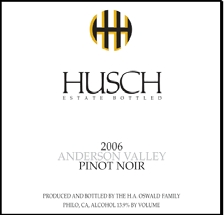 2007 Husch Vineyards Anderson Valley Pinot Noir 13.9% alc., 3,938 cases, $23. To be released in June 2009. Fermented in small, open-top fermenters and punched down three times per day. Aged 10 months in 25% new French oak barrels. · Moderately light reddish-violet color. A simple but thoroughly satisfying wine featuring red berries, crushed cherries, savory herbs, tobacco, and a deft touch of oak vanillin. Terrifically smooth mouth feel with gossamer tannins. Not a wine to contemplate and won’t send pinotphiles into ecstasy, but impossible to find a better easy-drinking California Pinot Noir for this price. Great Pinot bang for the buck.
At the Festival tasting I also sampled the 2006 Husch Reserve Anderson Valley Pinot Noir (14.0% alc., 438 cases, $35) which receives extended aging in 50% new French oak barrels. This is a magnificent wine similar to the regular Anderson Valley Pinot Noir but amplified in intensity and complexity and well worth your interest. For an additional treat, I tasted the 2005 Husch Knoll Anderson Valley Pinot Noir (13.9% alc., 425 cases, $38). This is an intense wine that is very brooding and earthy showing rich cherry and berry fruit highlighted with oak. It still needs several years to reach its optimum drinking window but it is clearly a marvelous wine of great pedigree made from 37-year-old vines.
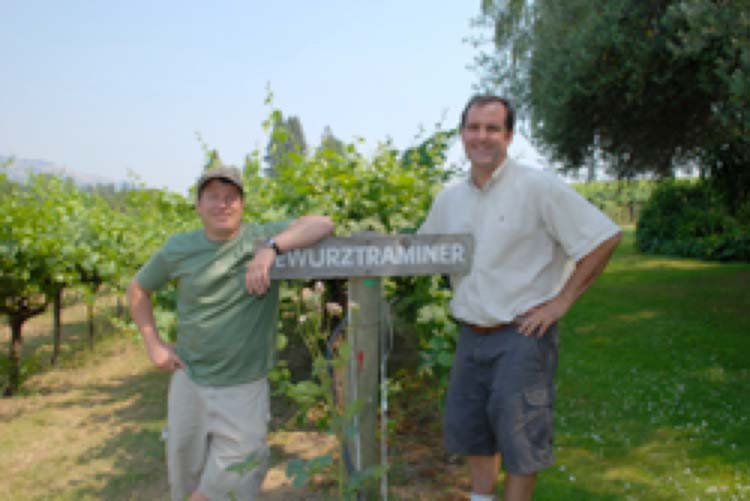
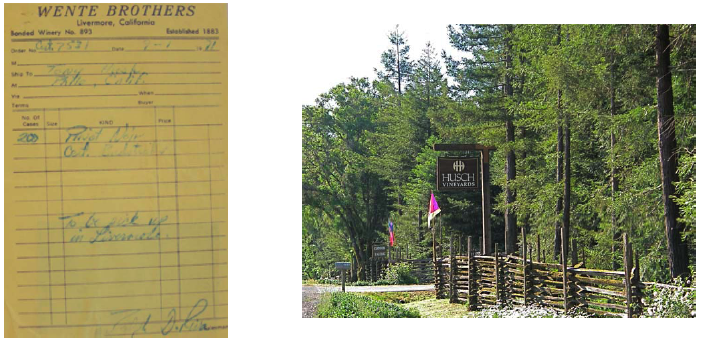
Jim Ball Vineyards Chicago attorney Jim Ball had such a love for Pinot Noir and the Anderson Valley he left his career to pursue his desire to make his own wine. His dream took root nearly ten years ago with the development of the Middleridge Ranch located at 1,200 feet on a south-facing hillside just outside of Boonville.
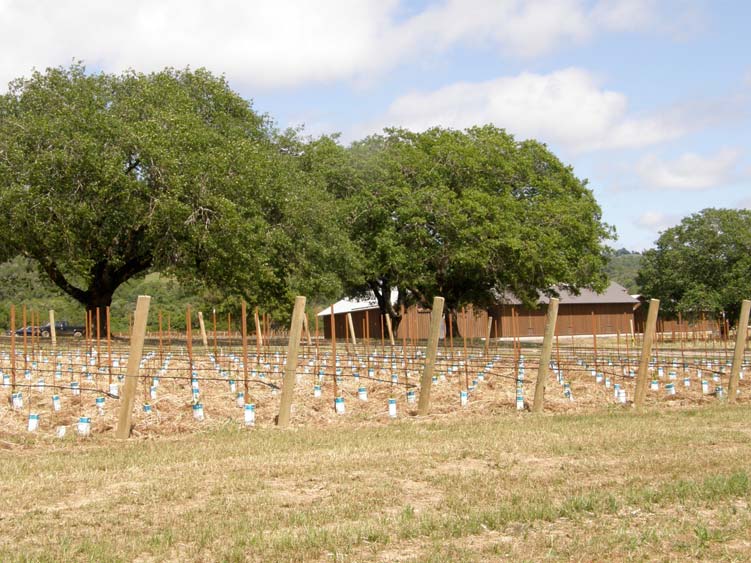
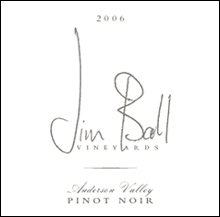 2007 Jim Ball Vineyards Signature Label Anderson Valley Pinot Noir 14.5% alc., $46. · Moderately deep garnet color. Very intense aromas of cherries and berries with Provencal spices. Rich and ripe berry and stone fruit flavors augmented by notes of tar and grilled meat. Smoothly textured with fine dusty tannins and a clean finish. A hardy wine with more gumption than the 2006 vintage. It will improve over the next year or two yet is drinking fine now.
La Crema Winery A family owned estate in the Russian River Valley that specializes in Burgundian styled Chardonnays and Pinot Noirs from cool climate vineyards in Sonoma, Monterey and Mendocino counties. Established in 1979, the winery has always been closed to visitors, but the label quickly gained a reputation for quality at reasonable prices. The owners are Laura Jackson-Giron and her sister Jennifer Jackson. Several prominent winemakers developed the La Crema Winery style through the years including Dan Goldfield (Dutton-Goldfield) and Jeff Stewart (Buena Vista). In 2004, La Crema hired Melissa Stackhouse to oversee winemaking and the wines have reached a remarkable level of quality considering the relatively large production and value-pricing. La Crema wines are consistently among the best sellers on restaurant wine lists (even in Napa Valley). All the Pinot Noirs except the reserve Nine Barrel bottling are appellation blends. When friends new to wine ask for a recommendation of a value-priced good Pinot Noir, I often recommend La Crema. They usually thank me afterward, but is no secret and an easy recommendation to make. La Crema wines are sold on the website at www.lacrema.com and through wine stores and supermarkets. A tasting room is open daily in downtown Healdsburg.
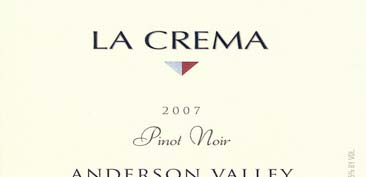 2007 La Crema Anderson Valley Pinot Noir 14.5% alc., 1,800 cases, $30. Released January 2009. Clones 115, 667, 777 and 23. Grapes are de-stemmed, cold soaked 4 days, aged 9 months in 48% new French oak (medium and medium plus toast levels). · Moderate garnet color. Lovely perfume of cherries and berries with sage. Powerfully flavored ripe berry fruit with a base of minerals and earth. Very friendly in the mouth with a creamy, sexy quality and plenty of vim on the tangy finish. A high-collared and impressive wine.
Lazy Creek Vineyards The history of this iconic vineyard and winery was profiled in Volume 6, Issue 28. The current owner is Ferrari-Carano who operates this property as a separate winery.
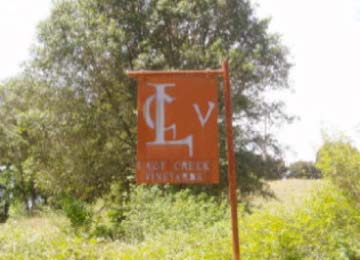
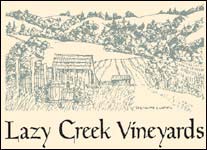 2007 Lazy Creek Vineyards Anderson Valley Pinot Noir 14.1% alc., 880 cases, $39. Release scheduled for Spring . The last vintage crafted by the previous owners (Josh and Beth Chandler and David Noorthoek, M.D.). · The nose is flush with dark red berries, cherries and plums with a hint of alcohol. A fruit-driven wine with a spark of underlying citrus. The prominent tannins and acidity overwhelm the fruit now but definitely worth revisiting when released next year.
Littorai Proprietor and winemaker Ted Lemon is a man among boys when it comes to crafting ultra-premium Pinot Noir in California. His story is quite unique. Fluent in French, he studied at the University of Dijon in Burgundy while still a high school student. He returned on a fellowship in 1980 to study viticulture and enology at the Universite de Bourgogne. After apprenticing at several notable Burgundy Domaines including Dujac, DRC, Roumier and Bruno Clair, he returned to the United States to work at Calera Winery. In 1982, while at Calera Winery, he received a phone call from Jacques Seysses of Domaine Dujac asking him if he would like to become the winemaker at Domaine Guy Roulot in Meursault, one of the oldest and most traditional wineries in Burgundy. He became the first, and to this day the only American winemaker and vineyard manager in Burgundy’s storied history (photo of a young Lemon below in Burgundy). Lemon was able to quickly assimilate and overcome the skepticism of the village people. His wines were very good and he quickly became accepted by the locals. After two years at Domaine Roulot, he was lured back to the United States by a French family that had purchased a vineyard on Howell Mountain above Napa Valley. At Chateau Woltner, Lemon crafted Chardonnays that soon became a favorite among American wine connoisseurs.
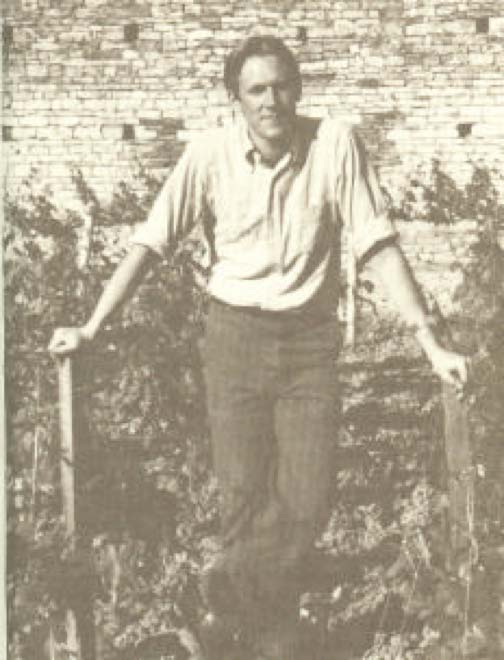 With his winemaking skills honed and assured, Lemon and his wife Heidi founded Littorai in 1993. He had spent a summer with his wife driving up and down the Pacific Coast tasting local wines and learning about the soil and history of local vineyards. Lemon had a firm belief in terroir and biodynamic farming inspired by his years in France. According to Lemon, “I believe soil is of major importance in a wine’s character. It’s clear there are tremendous differences between wines made from vineyards right next to each other even if they are vinified and treated exactly the same way.” Finally, Lemon settled on western Sonoma and Mendocino counties for his grape sources. He believed the finest Pinot Noir and Chardonnay were grown along the true coastal zone of the continent and was convinced that the mesoclimates of the extreme western portions of the continent north of San Francisco were diverse enough to create a series of unique terroirs, each with its own characteristics. He named his new venture Littorai which is a pleural noun formed from the Latin word litor-, which means the coasts. The word Littorai (lit‘-tor-i), with its reference to geography, reminds us that wine, the noblest agricultural product, arises from the weave of place (vineyard), time (vintage), and man. Littorai’s vineyard sources are all carefully supervised by Lemon and include Summa, Thieriot, The Haven and Hirsch on the Sonoma Coast and Savoy, One Acre, Cerise and Roman in the Anderson Valley. He has developed a few vineyards himself including a small estate vineyard (The Haven) that is farmed biodynamically (his impressive compost is shown in the photo below). Littorai was the first modern winery to create a “by-the-acre” contract for grapes. The first contract was written in 1993 for One Acre Pinot Noir. These contracts, in which growers are paid for the quality, not the quantity, of what they grow, have now become the norm for vineyards throughout California. Littorai demonstrated back in 1993 that world class production could be achieved by low yields, proper clones, vertical trellising, leaf removal and other farming techniques. Littorai has maintained long-term commitments with great vineyard sites, an exceptional record of terroir-based winemaking for California. Read Lemon’s take on biodynamics: http://wine.appellationamerica.com/winereview/698/Littorai-Wines.html
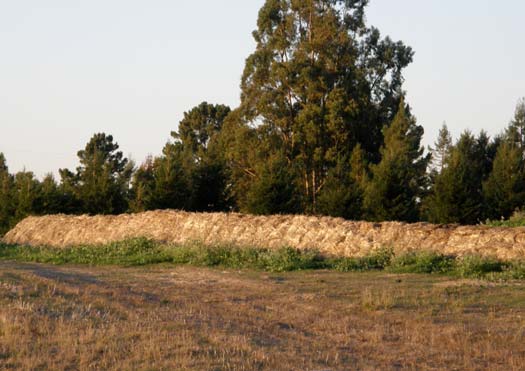
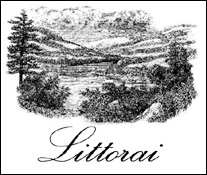 Lemon’s Pinot Noirs and Chardonnays are highly lauded and age worthy. I consider Littorai Pinot Noirs to be among the finest I have ever drunk from the New World. Some call him “the” Pinot Man. The wines are only sold through a mailing list and to restaurants. Periodically Lemon releases library wines from older vintages as well as large format bottlings. Recently, a 10,000 case winery was completed on Lemon’s estate in Sebastopol and he now accepts visitors for tasting and tours by appointment (707-823-9486). Ted doesn’t believe in frau-frau and his labels are simple and to the point with no BS on the back. He doesn’t follow trends or ratings. The wines do the talking. His autograph is in every bottle. Lemon has been a consultant for numerous prominent wineries including Howell Mountain Vineyards, Reverie, Green and Red Vineyard, Keller Estate, Estancia and Archery Summit. He currently is involved in a Pinot Noir project in Central Otago, New Zealand. He also is a winemaker for Chronicle Wines, producer of terroir-driven Pinot Noir and Zinfandel (www.chroniclewines.com). Chronicle was pouring at the Anderson Valley Pinot Noir Festival but I did not get an opportunity to sample the wines. In 2006 a Pinot Noir from the Sonoma Coast (495 cases, $35) and a Cerise Vineyard Anderson Valley Pinot Noir (240 cases, $48) were released. The Chronicle Pinot Noirs are available at www.goldengatewinecellars.com.
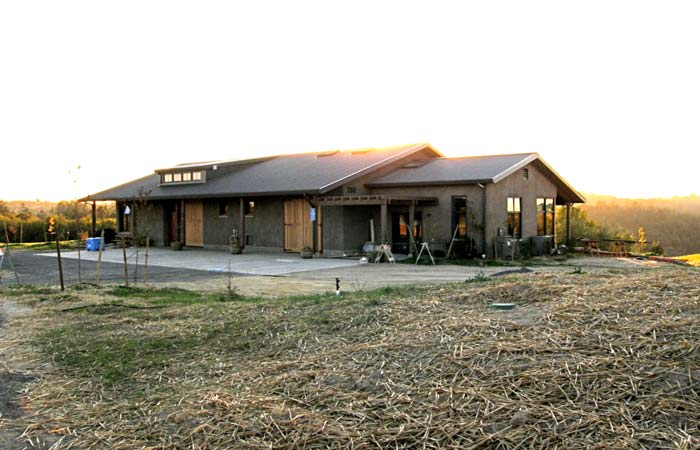 All the wines reviewed below are impeccably crafted. Perfect harmony comes to mind. You may not love every wine but you cannot complain about the superb craftsmanship that fuels the impeccable balance of the wines.
2005 Littorai Les Larmes Anderson Valley Pinot Noir 14.1% alc., 303 cases, $42. A vintage marked by more tannins and concentration. · Moderately light reddish-violet color. This wine speaks of the earth throughout. Brambly red cherry and plum aromas and flavors with a hint of funkiness, hay, meat and tar. Bright acidity makes for refreshing drinking.
2006 Littorai Les Larmes Anderson Valley Pinot Noir 14.2% alc., 293 cases, $45. Composed of declassified fruit from Cerise and Savoy vineyards and intended for earlier drinking. · Subdued but very pleasing scents of cherries, hay and white pepper. Admirable richness with bright flavors of cherries and red apples flanked by bright acidity. Smoothly textured and easy to drink. I call the Les Larmes bottlings, which are a blend from the Anderson Valley appellation, “Baby Littorai” wines, as they are perfectly good daily drinkers that will show well at the table and demand no contemplation. Like babies, they are fun when they are young.
2005 Littorai Roman Vineyard Anderson Valley Pinot Noir 13.5% alc., 36 cases, $65. This vineyard, owned by Al and Lynn Roman, is located just above Esterlina Vineyard high up Holmes Ranch Road. Only 1.87 acres in size, it sits on a knoll facing due south with full sun exposure. The vineyard has been controlled and organically farmed since the start by Littorai and the fruit is exclusively Littorai’s. · Complex aromatic profile of black cherries, spice, grass and smoke. Woodsy cherries, cardamon and tea with a pleasingly soft texture, fine ripe tannins and a dry finish. This wine has a certain lightness, airiness if you will, making it enticingly elegant.
2000 Littorai Savoy Vineyard Anderson Valley Pinot Noir 14.2% alc., $50. · Deep color with a slight orange tinge to the rim in the glass. The nose is brimming with black cherry fruit enhanced with a gorgeous secondary bouquet of coffee, cardamon spice and leather. A plush and creamy palate of roasted plum, root beer, brown spice and tobacco flavors robed in supple tannins and finishing with a lively grip on the persistent finish. This wine is showing its age beautifully and will be orgasmic for lovers of older Pinot Noirs.
2003 Littorai Savoy Vineyard Anderson Valley Pinot Noir 14.4% alc., 220 cases, $50. · A subdued nose of cherries and hay field. Tasty ripe strawberry, black raspberry and black cherry fruit that is vivid and penetrating. Admirable finesse with mild dry tannins and a persistent meatiness and earthiness to the finish. Beautifully composed wine with still plenty of life for the long haul.
2006 Littorai Savoy Vineyard Anderson Valley Pinot Noir 14.2% alc., 379 cases, $60. From a vintage in which the wines are marked aromatically by fruit and flower, generally have less tannins, and earlier approachability. · Noticeably lighter and redder in color and lighter in weight than previous vintages from this vineyard. Delicious ripe strawberry and cherry fruit accented with baking spices and hay. Gossamer tannins create a soft and rather elegant wine that lacks a little punch on the mid-palate. A bright wine that will perform beautifully at the table.
Rich Savoy was a former book store owner in San Francisco who became one of the premier growers of wine grapes in the Anderson Valley. The meticulously farmed vineyard sits on the valley floor just off of Highway 128 west of Philo. There are multiple clones of Pinot Noir planted in 1991 and 1992, including Dijon clones 114, 115, 667, 777 plus Pommard, Calera, Martini and Wädenswil. Chardonnay is also planted. Over the years, the vineyard management has shifted to sustainability and incorporation of more organic practices. The Pinot Noirs from Savoy Vineyard tend to be earthier in style with darker fruits, grilled meat, mushroom and forest floor characters. The wines take years to evolve, then revealing multiple layers of flavors. Multiple premium producers have accessed grapes from this vineyard including Adrian Fog, Barnett, Benovia Winery, Breggo Cellars, Drew, Radio-Coteau and Roessler Cellars. Littorai was the first to bottle a vineyard-designate wine from Savoy Vineyard. Rich Savoy also owns the Deer Meadow Ranch located 1,600 feet on a ridge above Boonville. A piece of the Deer Meadow Ranch is known as the One Acre Vineyard, contracted exclusively to Littorai in 1993. The vineyard was torn out and replanted after the 2004 vintage due to root louse infestation. The original plantings dated to 1986 and were Martini and Mount Eden selections and Wädenswil clone. Some of Deer Meadow Ranch fruit goes to La Crema.
2004 Littorai One Acre Anderson Valley Pinot Noir 14.1% alc., 140 cases, $70. The final vintage from this vineyard which underwent replanting due to phylloxera. As Lemon says using an opera analogy, “The fat lady came out for one last belt.” This vineyard was planted on poor soils on the Dear Meadow Ranch owned and farmed by Rich Savoy. · Penetrating aromas of crushed black cherries, ripe berry jam and spice. A special wine that is layered with rich berry fruit and an appealing earthiness that reminds a walk in a freshly dewed forest. The smooth mouthfeel is very comforting and the finish would make Hollywood proud. A profound 100 point Pinot Noir that one could sip all night.
2004 Littorai Cerise Vineyard Anderson Valley Pinot Noir 13.7% alc., 95 cases, $60. This vineyard is planted to the Martini clone. · Moderately dark reddish-violet color. Initially shy, the nose explodes over time in the glass with volumes of black cherries and blackberries. Richly flavored but ephemeral in style with earth-kissed fruit, beet root and a hint of metal. The tannins have begun to melt away creating a very smooth and satiny mouth feel. Impeccable balance. Close to the One Acre in sensual pleasure.
Londer Vineyards You won’t find two more friendly winegrowers than Larry and Shirlee Londer. They are transplants from Albuquerque, New Mexico who moved to the Anderson Valley in 2000 to find solace and happiness. Running a winery owned by investor partners has not been easy according to Larry and he had no idea what he was getting himself into when he left a successful ophthalmology practice. He kids, “We work eight days a week and still don’t have enough time!” Larry had wanted to name the venture Anderson Valley Vineyards, but the name had already been taken by a winery in Albuquerque and they wouldn’t relinquish it. The Londers planted a 15-acre Pinot Noir estate vineyard and began sourcing grapes from several notable vineyards in Anderson Valley (Ferrington, Donnelly Creek, Corby and Valley Foothills) and Sonoma County (Kent Ritchie). Winemaker Greg La Follette got them started and they quickly received acclaim for their Pinot Noir, Chardonnay and Gewürztraminer. La Follette’s protege, Richard Davis (Halleck, Calstar and La Czar) has taken over and continued the success. The Londer estate is stunning with a vineyard encircled by fruit orchards and towering redwoods. The wines are produced in the Owl Ridge custom crush facility in Sebastopol. The Londers have talked about opening a tasting room for some time, but for now, tastings are conducted in the Londer’s kitchen at home (707-895-3900). Shirlee is the smiling face of the operation, managing the difficult task of selling and marketing the wines. The wines are sold through a mailing list with some retail distribution (www.londervineyards.com). Production is now 5,000 cases annually. The Londer Pinot Noir style is bold with copious fruit concentration and is well structured to age. The Ritchie Vineyard Chardonnay is a Kistler slayer. Photo below shows Richard Davis (left) and Shirlee and Larry Londer in the center at their winery open house.
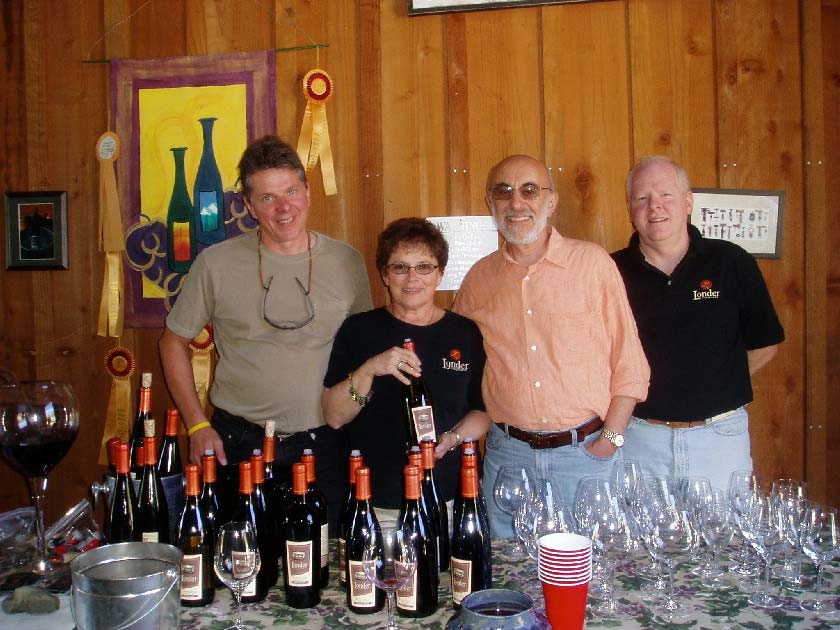
 2006 Londer Paraboll Anderson Valley Pinot Noir 15.0% alc., 524 cases, $54. Released May 2008. The derivation of the name is “para” which is an art classification for a deep cherry-red color and “boll” which is boontling for great. A reserve blend that is sourced from Ferrington and Valley Foothills Vineyards. Wild yeast fermentation, aged 9 months in French oak barrels. · Deep, dark reddish-purple color. A generous core of dark cherry and berry fruit which is complemented by loam, spice, cola, bacon and a hint of nuttiness. Sorting ample tannins and brisk acidity and leaving a little heat in its wake on the richly-fruited finish.
MacPhail Family Wines This label was founded in 1998 by James MacPhail who had a passionate devotion to Pinot Noir. He learned his winemaking in the mid 1990s at Quivera, Pellegrini and Merry Edwards. A Pinot Noir specialist, MacPhail released his first wines sourced from vineyards in Sonoma and Anderson Valley appellations in 2002. Most recently, the wines are handcrafted in small lots in a new eco-sensitive winery in Healdsburg built in MacPhail’s own backyard. The style is rich and ripe and reflective of Merry Edward’s Pinot Noirs. The wines are sold through a mailing list (www.macphailwine.com) and thru retail channels. The Radio Flyer wine label and marketing program are very eye-catching and the wines do not disappoint. For 2007, Anderson Valley Pinot Noirs include bottlings from Toulouse Vineyard, Frattey Shams Vineyard, Wightman House Vineyard, Ferrington Vineyard and Pratt Vineyard. Production is about 1,500 cases annually. Tasting is available by appointment on weekdays (call Kim Welch at 707-433-4780).
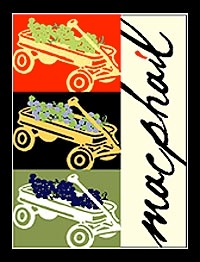 2006 MacPhail Anderson Valley Pinot Noir 14.7% alc., 675 cases, $38. Clones are 115, 667, 777 and Martini. Native fermentation, aged 11 months in French oak barrels. · Moderately light ruby color. Very fragrant brambly cherry and cranberry fruits highlighted with savory herbs. Fresh herbed berry flavors with citrus in the background. A little creamy with restrained dry tannins and a bright finish marked by a whiff of alcohol. Nothing special but very decent and will have fans.
2005 MacPhail Ferrington Vineyard Anderson Valley Pinot Noir 14.24% alc., 325 cases. Clones 2A, 115, 777. Native fermentations, aged 11 months in French oak barrels, unfined and unfiltered. · Attractive aromas of strawberry tart, cola and gentle oak. An earthy wine with plenty of berry fruit, a trace of spice and an undercurrent of greenness. Gossamer tannins and bright acidity. Just o.k. for me.
2005 MacPhail Toulouse Vineyard Anderson Valley Pinot Noir 14.9% alc., 375 cases. Clones 2A, 115, 667 and 777. Native fermentations, aged 11 months in French oak barrels, unfined and unfiltered. · Charming and complex aromatic mix of red plums, strawberries, redwood and some good funk. Nicely composed and layered red fruit palate that is lip-smacking. Perfectly balanced with suede tannins, a pillowy texture and complete integration of the alcohol. Very Caliesque in style and utterly hedonistic.
Navarro Vineyards Navarro’s historical place in the Anderson Valley was profiled in Issue 18. Navarro began planting grapes in the Anderson Valley in 1974. Thirty-five years later, the children of founders Ted Bennett and Deborah Cahn, Aaron and Sarah Cahn Bennett, are now actively involved in the winery as well. Sarah received a Masters degree and enology and viticulture from University California Davis and has filled the roll of enologist at Navarro Vineyards. She has applied her research on the phenolics of Mendocino Pinot Noir to Navarro’s already stellar lineup of Pinot Noirs. Aaron designed Navarro’s first website in 1996, and his internet savvy adds to Navarro’s impressive marketing history. Navarro’s winemaker for over 15 years has been Jim Klein (pictured below at the Festival). Navarro now produces 40,000 cases of wine annually, 10,000 cases of which are Pinot Noir. The winery farms nine vineyard sites and is currently adding to its plantings. A second new winery is under construction in Boonville. There are three Pinot Noirs produced: a Mendocino appellation blend, a Méthode a l’Ancienne Anderson Valley Pinot Noir, and a Deep End Blend Anderson Valley Pinot Noir. The wines are sold primarily to a loyal customer mailing list and online at www.navarrowine.com. Retail distribution is limited and some of the small release wines are only made available to wine club members. The tasting room and original winery are located at 5601 Highway 128 in Philo. The tasting room is open daily from 10:00 to 6:00 and the grounds are perfect for picnicking. Tours are offered daily. Many members of the staff, from tasting room and office managers to cellar workers, all have several family members working at the friendly winery.
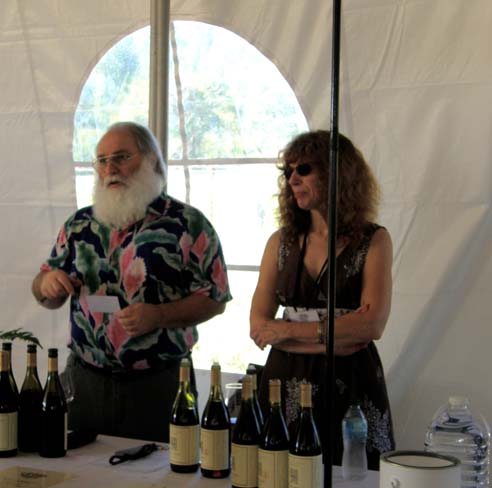
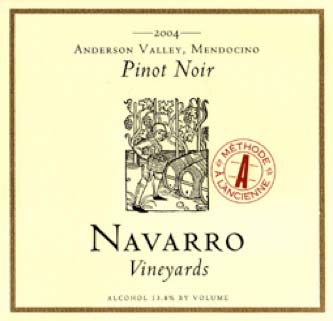 2007 Navarro Vineyards Deep End Blend Anderson Valley Pinot Noir 13.9% alc., 1,572 cases, $49. Release date March 2010. Harvest Brix 26.5º. Clones are 114, 115, 667, 777 and Pommard 4. · This is a precocious wine that is very approachable now. Charming perfume of a fresh cherry pie with a hint of oak spice. Plums and berries lead the balanced attack with a perfect tug of acidity. Smooth and refined with an appealing elegance. Pick any superlative you want. Could be the best Anderson Valley Pinot Noir I tasted at this year’s Festival.
Phillips Hill Estates Owner and winemaker Toby Hill had a successful career in the art business in New York but longed for a less harried lifestyle. He moved to California and found his piece of heaven in the hills of Philo on Philo Greenwood Road overlooking Anderson Valley. He built a house and an adjacent art studio, but when some unfinished Pinot Noir became available in 2002, the study was transformed into a winery and Hill released his first Pinot Noir. He now sources grapes from Oppenlander Vineyard on Shandel Ranch in Comptche’s Surprise Valley (just north of Anderson Valley) and Toulouse, Corby and Marguerite vineyards in Anderson Valley. John Pope, who also crafts wines for Shandel’s Oppenlander Vineyard label, assists Hill in the winemaking duties. A new tasting room is open in Philo at 8627 Highway 128. Call 707-895-2209 for hours. I have enjoyed the wines which are crafted in a very approachable elegant style.
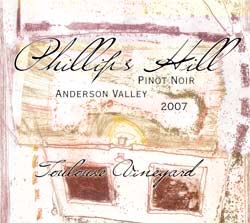 2007 Phillips Hill Estates Anderson Valley Toulouse Vineyard Pinot Noir 14.2% alc., 175 cases, $42. From a 17-acre vineyard owned by Vern and Maxine Boltz in the deep end of the Anderson Valley. Planted in 1997. Yields 3 tons per acre. 33% each Dijon 115 and 667 and 2A. Whole berry fermentation, 5 day cold soak, 15 days on skins. Aged 11 months in 35% new French oak barrels. · Black cherry is the theme here both in the aromas and flavors. Very light and delicate, smoothly textured, with a touch of oak spice, fuzzy tannins and a respectable acid lift on the finish. A feminine wine that tries but fails to seduce me.
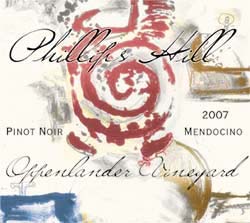 2007 Phillips Hill Oppenlander Vineyard Comptche Mendocino County Pinot Noir 14.2% alc., 450 cases, $42. The 18-acre Oppenlander Vineyard is located 8 miles from the Mendocino Coast as the crow flies. Planted in 1998 and 1999, this is one of four vineyards in this emerging cool climate region. Dijon clones 114, 115 and 667, Pommard clone, Martini selection, all self-rooted. The soil is Oppenlander heavy clay loam unique to Comptche. Yields were 3 tons per acre. Whole berry fermentation, 4 day cold soak, 16 days on skins. Aged 11 months in 40% new French oak barrels. Unfined and unfiltered. Label says, “The momentum of the place gives it a completeness.” · Darkest colored of the 2007 lineup. Deep, rich and dark stone and berry fruits especially black raspberry. A masculine wine reflective of this vineyard sporting muscular blackberry and black raspberry flavors with a hint of grapefruit on the back end. Still reserved and needs some time to evolve. Beautifully crafted.
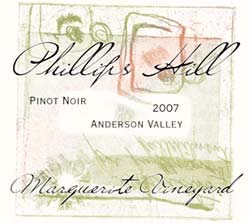 2007 Phillips Hill Marguerite Vineyard Anderson Valley Pinot Noir 13.9% alc., 50 cases, $37. Sourced from a ridge top vineyard on the east side of the Anderson Valley located on the old Holmes Ranch property at 1,300 feet. Yields 2 tons per acre. Grafted from Chardonnay to Pinot Noir clones 115 and Molinari in 2002. Whole berry fermentation, 5 day cold soak, 16 days on skins. Unfined and unfiltered. Label says, “Here lives the inspirational possibility of reinvention mixed with a little jene sais quoi.” · Oak char and earth command the nose. Darker berries are featured but oak is the strongest player and thoroughly dominates the delicate fruit.
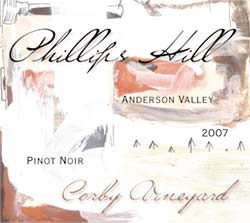 2007 Phillips Hill Corby Vineyard Anderson Valley Pinot Noir 14.0% alc., 350 cases, $40. The Corby Vineyard was planted in 1995 along the east side of the Navarro River in the direct route of the fog channel from the Mendocino Coast. This is the first single vineyard-designate from this vineyard and may be the last as the property has been sold. 50% Pommard and 50% Dijon 115 clones. Yields were 2.5 tons per acre. Whole berry fermentation, 6 day cold soak, 16 days on the skins. Unfined and unfiltered. Aged 11 months in 40% new, 20% 1-year, and 40% seasoned French oak barrels. · Moderately light garnet color. The nose offers redder fruits, particularly Morello cherries, with a hint of flowers, grass and oak. Medium weighted cherries and strawberries on the palate with a touch of baking spices. Very sensual and satisfying mouth feel. Tasted twice with different impressions. At the Press tasting I was very impressed and rated the wine as excellent. Tasted at home I found it to be good but not exceptional. Pinot Noir is such a minx of a wine that declarations are always subject to the moment.
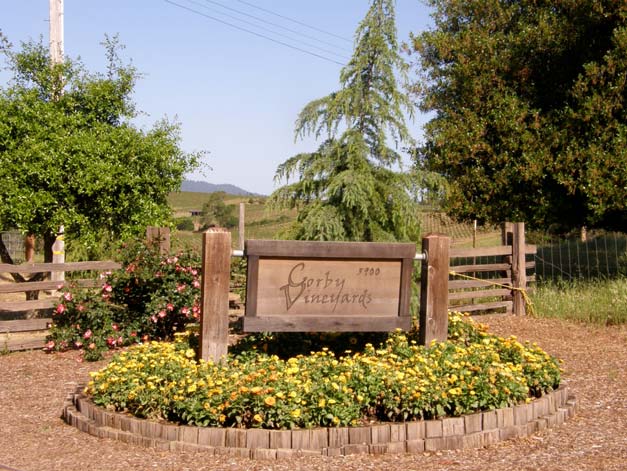
2005 Philo Ridge Vineyards Anderson Valley Pinot Noir 13.3% alc., 250 cases, $32. The fruit is sourced primarily from Ferrington Vineyard. Clones 115, 667 and 777. Picked at 23.5º Brix. Slow fermentation in 1-ton open top fermenters, 4 day cold soak, aged 18 months in 50% new French oak barrels. Aged 9 months in bottle before release. · Moderately light in color. The nose is very floral with a green note. Attractive flavors of fresh berries and cherries with a riff of oak. Soft and smooth with supple tannins.
Raye’s Hill Vineyards & Winery Raye and Dan Sokolow are Chicago natives who moved to Anderson Valley and planted their estate vineyard in 1997. They studied winemaking at University California Davis and gained experience assisting other wineries. The Sokolows currently craft 1,000 cases of wine, primarily Pinot Noir, from their estate vineyard and other notable vineyards in the valley. The wines are sold on the website at www.rayeshill.com. 707-895-3439. This producer is a “sleeper” in that the label is not well known or marketed, yet the wines are quite good and very sensibly priced. Definitely worth a look.
 2005 Raye’s Hill Vineyards & Winery Henneberg Vineyard Anderson Valley Pinot Noir 14.2% alc., 280 cases, $26. Released January 2008. The 14-acre Henneberg Vineyard is owned by Matt and Jeannie Henneberg and is located in the deep end of the Anderson Valley. 100% Pommard clone. 3-day cold soak, fermentation in 1-ton open top fermenters, pressed into French oak barrels and aged for 16 months. · This is a pleasing wine that has attractive aromas and flavors of brown-spiced ripe cherries and cola. Good backbone of ripe tannins and brisk acidity on the refreshing finish. A great value in a hand crafted artisan Pinot Noir. All the Raye’s Hill Pinot Noirs are similarly priced.
Roederer Estate Jean-Claude Rouzaud, Chairperson of Champagne Louis Roederer and grandson of Madame Camille Olry Roederer, chose the 58-acre Anderson Valley vineyard and winery site in 1981. Roederer now farms over 580 acres of Pinot Noir (primarily sparkling clones 32 and 33, Pommard, and Dijon 114, 115, 667 and 777). All wines are made from estate grapes. The winemaking team is all French headed by Arnaud Weyrich. Roederer (Maisons Marques & Domaines) also owns nearby Schraffenberger Cellars. Roederer Estate has been quietly making a still Pinot Noir since 1992 which is only sold through the tasting room. The barn-inspired tasting room is open daily from 11:00 to 5:00 at 4501 Highway 128 in Philo. The website is www.roedererestate.com. 707-895-2288. The winery’s superb sparkling wines (Anderson Valley Estate Brut, L’Ermitage, Estate Brut Rosé, and vintage dated L’Ermitage Rosé) are widely distributed.
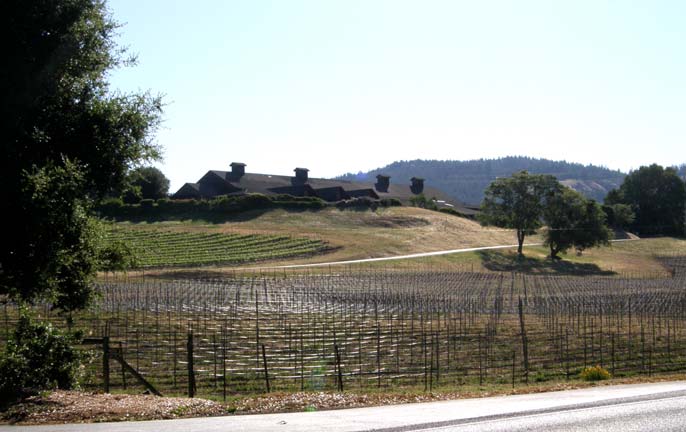
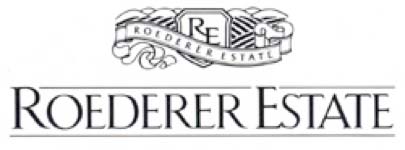 2006 Roederer Estate Anderson Valley Pinot Noir 13.8% alc., 397 cases, $24. Released May 2007. A blend of Pommard, 114, 115, 667, 777 and other clones. Yields 2 to 3.5 tons per acre. 100% destemmed, 31% cold soaked, manual punch downs, light filtration, aged 10 months in 19% new French oak barrels. · Delicate light color. Very floral and grassy nose. Demure ripe strawberry and cherry flavors with plenty of finesse and a spark of acidity. A rosé sparkling wine without the bubbles. Will match beautifully with simply prepared salmon.
Roessler Cellars Brothers Richard and Roger Roessler founded Roessler Cellars in 2000. Together with talented winemakers Wells Guthrie (consulting) and Scott Shapely (formerly of Crushpad and Siduri Wines), they craft marvelous Pinot Noirs from appellations throughout California. Roessler produces four appellation wines: Red Label (Sonoma County), La Brisa (Sonoma Coast), Bluejay (Anderson Valley) and Peregrine (Sta. Rita Hills) plus multiple vineyard-designate wines. Total production of 7,300 cases includes 14 different Pinot Noirs. An estate vineyard is planted in the true Sonoma Coast in northernmost Sonoma County. Roessler Cellars’ business office is located off of the town square in Sonoma. A $6 million winery has been built in the Petaluma Gap region of Sonoma which will allow production to increase to 12,000 cases. Tasting is by appointment (707-933-4440). The wines are sold on the website at www.roesslercellars.com and widely distributed in fine wine shops. This is a go-to label that you can count on for consistently fine wines.
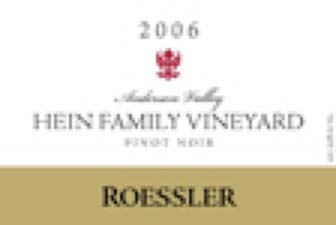 2007 Roessler Cellars Hein Family Vineyard Anderson Valley Pinot Noir 14.1% alc., 196 cases, $45. Released scheduled for September 2009. This vineyard was planted between 1997 and 1999. Pommard and three Dijon clones. · Moderately deep ruby color. The nose offers intense black fruit aromas. Richly flavored dark Pinot fruits complemented by notes of tobacco and dark chocolate. Soft in the mouth and plush in texture. A brooding wine that will need a few years to reach its apex. Can be drunk now with short ribs or a steak.
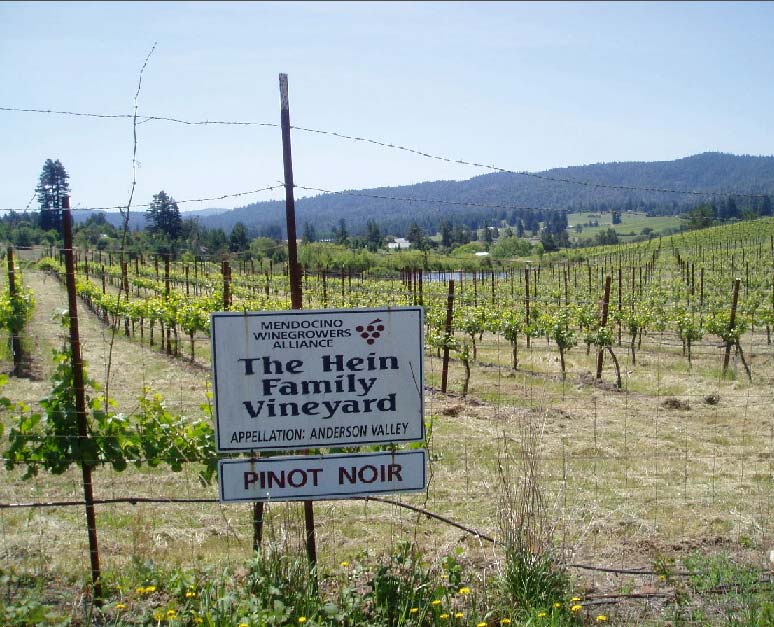
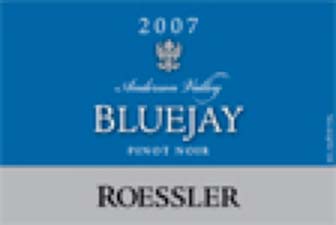 2007 Roessler Cellars Bluejay Anderson Valley Pinot Noir 14.4% alc., 1,076 cases, $32. Named for the populace of bluejays west of Philo. · Deeply colored. Aromas of black cherries, spring flowers and oak. Picks up intensity in the glass. A moderately light wine that drinks easy. Both black and red fruits, mild dry tannins, a touch of oak and a pleasing finish. Nicely balanced to work with food. Fine for what it is.
Saintsbury This iconic winery celebrated its 25th anniversary in 2006. David Graves and Richard Ward met at University California Davis and realized they had a shared passion for Pinot Noir. They staked their claim in Carneros, largely an unproven grape growing area in 1981. Despite no real business plan and very little money, they took the plunge. They released 2,000 cases of Pinot Noir from purchased grapes in 1981 and never looked back. By 1991, production had increased to 35,000 cases and their Pinot Noir was on practically every restaurant wine list in the United States. Saintsbury owed its success to offering wines with a high quality to value ratio. Graves and Ward like to kid about their success, thankful because, “Our attitudes and work habits make us otherwise unemployable.” Saintsbury is named in honor of George Saintsbury, a journalist and professor of rhetoric and English literature at the University of Edinburgh. He was a wine lover and in 1920, at the age of 75, published Notes on a Cellar which was a collection of opinions and notes about wine and wine dinners he had enjoyed over the years. Saintsbury has about 13 acres of vineyard around their unpretentious and weathered barn-like original winery in Napa Carneros and owns the Brown Ranch Vineyard nearby, but they source most of their grapes from Napa Carneros growers through long-standing relationships. Frenchman Jerome Chery joined Sainstbury as winemaker with the 2004 vintage, succeeding Brian Kosuge. That year, Saintsbury abandoned their reserve bottling and began producing a series of vineyard-designate Pinot Noirs from Napa Carneros and the Anderson Valley. Because of Chery’s training with Littorai’s Ted lemon, he espouses terroir-based vineyard-designate Pinot Noirs making the transition a natural for Saintsbury. A second winery has been built in Sonoma. The wines are sold on the website at www.saintsbury.com and through widespread retail and restaurant distribution. Tasting is available by appointment on weekdays (707-252-0592).
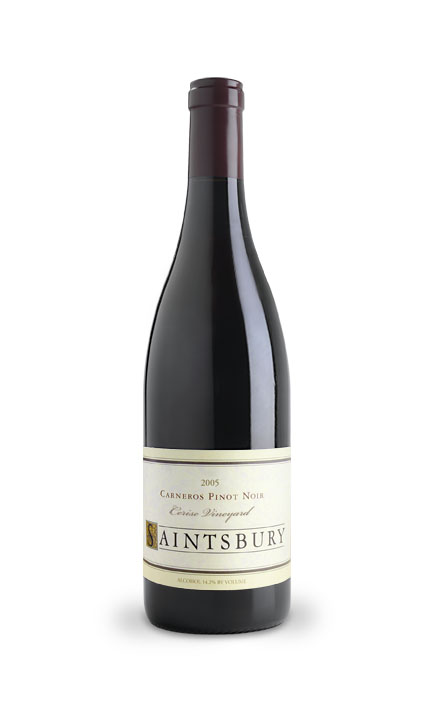 2007 Saintsbury Cerise Vineyard Anderson Valley Pinot Noir 14.0% alc., 1,150 cases, $45. Released August 2008. Th is 37-acre vineyard is located on steep slopes of the southwestern facing hills just north of Boonville and is planted to clones 115, 667, 777 and Pommard. Yields were 1.5-2.5 tons per acre. 7 day cold soak, 12 day total cuvaison. Aged 10 months in 24% new French oak barrels. The only Saintsbury Vineyard Series wine from outside Carneros. · Smoky, herbal aromas lead to a palate of full, rich dark fruits with earth and chocolate undertones. A muscular yet deft wine that has the acidity and structure to go the distance. Needs more time.
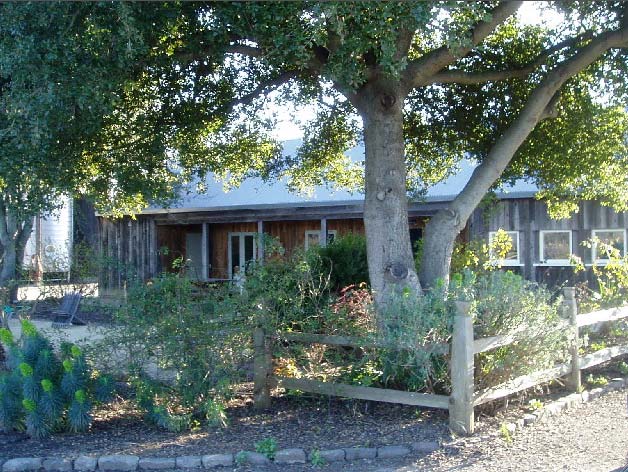
Schraffenberger Cellars Originally founded in 1981 by John Scharffenberger, this sparkling wine producer was sold in 1998 and renamed Pacific Echo. It was subsequently acquired by Maisons Marques & Domaines (Roederer) in 2004 and the original name restored. Tex Sawyer has been the winemaker since 1989. A still Pinot Noir is produced and sold in the tasting room located at 8501 Highway 128 in Philo (open daily from 11:00 to 5:00). The website is www.scharffenbergercellars.com. 707-895-2957.
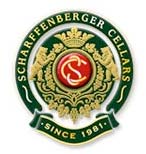 2004 Scharffenberger Cellars Anderson Valley Pinot Noir 14.3% alc., 578 cases, $23. Released May 2007. A blend of Roederer, Pommard and Dijon clones from Perkins-Clark, Redwood Grove and Day Ranch vineyards. Traditional vinification, light filtration. · This is a very ripe tasting wine veering toward currants and raisins. Smooth with silky tannins. A good back porch wine.
Skewis Wines Hank Skewis is a veteran of over 25 vintages who honed his winemaking skills at Lambert Bridge in the Dry Creek area of Sonoma County before launching his namesake label with his wife Maggie in 1994. That year, grower Fred Peterson of the Floodgate Vineyard in Anderson Valley(now owned by Goldeneye and renamed) offered Hank three barrels of grapes and Hank released 70 cases of Pinot Noir for sale. Today, he crafts just under 1,000 cases of Pinot Noir from vineyards in Sonoma’s Russian River Valley and Coastal appellations and the Anderson Valley. Hank’s vineyard sources have varied but have always been superb. Skewis wines are sold primarily through a mailing list and on the website at www.skewiswines.com. I have had a number of older vintages of Skewis Pinot Noir and I can vouch for their age ability. The wines demand patience for optimum enjoyment.
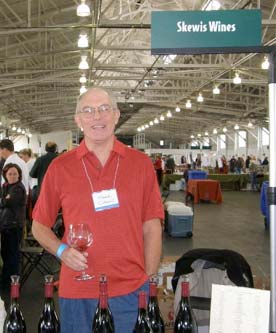
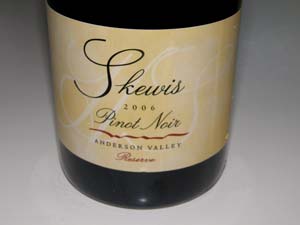 2006 Skewis Anderson Valley Reserve Pinot Noir 13.8% alc., 200 cases, $50. Harvest Brix 23.6º. · Fresh berry compote with a hint of spearmint on the nose. A demure and elegant wine featuring red berries and cherries and a hint of mocha. All velvet in texture. Lacks a little mid palate thrust but is a caressing wine that is easy to like.
Other Pinot Noirs:
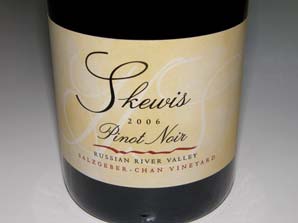 2006 Skewis Salzberger-Chan Vineyard Russian River Valley Pinot Noir 14.5% alc., 200 cases, $42.From a 3-acre vineyard planted in 1997 in the heart of the Russian River Valley appellation. Dijon clone 115. Harvest Brix 24.9º. · Scents of dark cherries, oak char and spearmint. Bright Bing cherry in the mouth with a nice touch of spice. Some oak char carries through in the background but dissipates some with swirling (should integrate with further aging of the wine). Appealing finesse and balance.
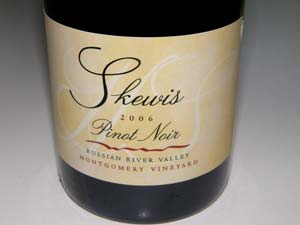 2006 Skewis Montgomery Vineyard Russian River Valley Pinot Noir 14.6% alc., 110 cases, $45. From a19-year-old vineyard west of Santa Rosa in the Olivet Road area. Harvest Brix 25.8º. · Dark ruby color. Scents of plum, cedar and spearmint. Darkly fruited with a citrus tang on the finish. A thick and rich wine with noticeable dry tannins. Still brooding and linear and needs more time in the bottle.
Standish Wine Company Founded in 2004 by Ken and Miles Oswald, longtime grape growers and winery principals. The winery sits on the Day Ranch, a former apple and pear orchard, which was purchased by the Oswalds from the Day Family in 1978. The Oswalds are distantly related to the famous Mayflower pilgrim, Miles Standish. Valerie Oswald and Lori Kraemer are the managing directors. The unique tasting room is upstairs in an old redwood apple-drying barn (photo below). The tasting room is open daily starting at 10:30 AM at 5101 Highway 128 in Philo. 707-895-9213. No website.
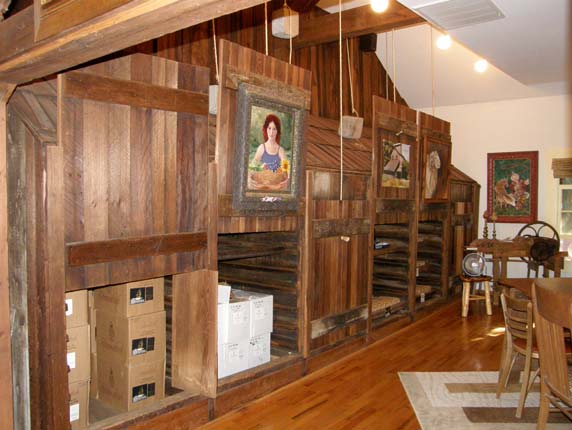
2007 Standish Bosc Block Anderson Valley Pinot Noir 14.9% alc., 48 cases, $70. Released May 2009. Jackson (23) clone. Brix at harvest 25.25 Aged 11 months in 90% new French oak barrels, two rackings, unfined and filtered. This wine was offered for sampling at the Festival Press tasting but I did not get a chance to taste it.
Toulouse Vineyards & Winery Ken and Maxine Boltz are urban refugees from the San Francisco Bay area where Vern was an Oakland Fire Department Captain and home builder, and Maxine was a flight attendant and real estate professional. They acquired 160 acres near Philo in 1997, cleared the land and planted a 17-acre vineyard to Pinot Noir. The clones are 2A, 115, 667 and 777. The vineyard is named Toulouse after a huge goose weighing in at up to 35 pounds that thrives in the tranquility of the vineyard. Toulouse supplies grapes to several other wineries (MacPhail, Baxter, Phillips Hill Estates) and produces a line of varieties under the Toulouse label at the estate winery. The Toulouse wines have improved each year as the vineyard has matured and are now among the best in the valley. A Riesling, Pinot Gris, Gewürztraminer are crafted from purchased fruit. The wines are sold directly at the winery and through fine wine retail stores. Tasting is by appointment, but if the gate is open it is worth checking to see if the Boltzs will receive you. The winery is nothing fancy and rather rustic, but that is not the point. You will be treated very well here by the affable and personable hosts. 8001 Highway 128, Philo. 707-895-2828.
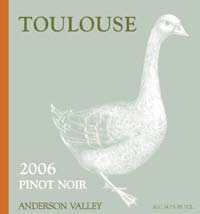 2007 Toulouse Vineyards Anderson Valley Pinot Noir 1,140 cases, $42. Released February 2009. · Moderately deep reddish-purple color. Lovely aromas of fresh cherries and spice. Mouth filling and concentrated flavors of Bing cherries, Asian spice, dark chocolate and smoke with a mild grip of tannins. Focused and tenacious with a smooth texture and very user friendly. Got duck?
Tudor Wines Since 2000, Dan Tudor and first-cousin Christian have been sourcing Pinot Noir from family owned vineyards in the Santa Lucia Highlands and Anderson Valley to produce small lots of premium Pinot Noir. The Tudor family has a long history of grape growing dating back several hundred years in Croatia. The Tudors began growing grapes in California in the early 1900s and still operate one of the largest table grape vineyards in the country. Dan Tudor made his first wines in 1982 in the Santa Maria Valley and the wines all won medals in amateur wine competitions. He has used the expertise of noted winemaker Larry Brooks since 1999 to guide him in Pinot Noir production. The wines are available through a mailing list and on the website at www.tudorwines.com along with limited retail distribution. In addition to the wine reviewed below, there is a 2006 Tudor Balo Vineyard Anderson Valley Pinot Noir ($59).
 2006 Tudor Anderson Valley Pinot Noir 14.3% alc., 825 cases, $39. Aged 10 months in French oak barrels. · Very charming scents of black cherries, oak, shoe leather and violets. Rich core of ripe black cherry and strawberry fruit with a hint of root beer and tea. Very soft and demure with fine-grain tannins and a persistent finish laced with tangerine peel. Everything is in place and this is a delight.
Twomey Cellars Twomey Cellars began as a Merlot specialist in 2000. In 2001, Raymond Twomey Duncan (a long time owner of Silver Oak Cellars) leased property on Westside Road in the Russian River Valley which became the centerpiece of the winery’s new Pinot Noir program. In 2006, Twomey began sourcing fruit from the Sonoma Coast and other California appellations. The former Roshambo Winery in Healdsburg was acquired by Twomey and retrofitted to produce Pinot Noir. Winemaker Ben Cane, who joined Twomey in 2007, oversees the winery’s Pinot Noir program. There are now four appellation Pinot Noirs from the Russian River Valley, Sonoma Coast, Anderson Valley and Santa Barbara County. Twomey offers tasting at both their Calistoga Soda Canyon Estate (where Merlot is produced) and Healdsburg Estate Monday through Saturday. Tours of the wineries are available by appointment. The wines are sold on the website at www.twomeycellars.com and through retail channels.
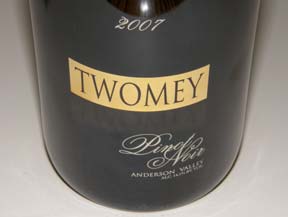 2007 Twomey Cellars Anderson Valley Pinot Noir 14.1% alc., $45. · Moderately light ruby color. Extroverted nose of blackberries, tobacco and violets. Very tasty core of lush black cherry and black berry fruits. The flavors attack in waves and hold on. Velvety smooth with soft tannins and balanced acidity. A seductive wine that perfectly fits the description of an iron fist in a velvet glove.
Waits-Mast Family Cellars Brian Mast and Jennifer Waits found the romance of wine by exploring California’s many wine regions. They remark, “Like a verse that haunts you, Pinot Noir kept on finding us, tapping our shoulder. It was always (and remains) our favorite varietal.” In 2005 they embarked on a journey to craft their own Pinot Noir under the guiding hands of Scott Shapley and Chris Nelson at Crushpad in San Francisco. The 2007 Pinot Noirs from Wentzel Vineyard in the Anderson Valley and La Encantada Vineyard in the Santa Rita Hills are the third releases. The wines are sold primarily through a mailing list and online at www.waitsmast.com.
2007 Waits-Mast Wentzel Vineyard Anderson Valley Pinot Noir 14.2% alc., 25 cases, $42. Sourced from the 10-acre Wentzel Vineyard located near Philo and organically farmed by Roland Wentzel. 100% destemmed, native fermentation, aged 11 months in 33% new French oak barrels. · An impressive wine filled with tasty dark cherry and berry fruit, an underlying green note, and sporting a smooth, velvety texture, gossamer tannins, and a refreshingly clean finish. Close to a Pinot Geek wine.
Woodenhead Proprietor and winemaker Nikolai Stez owes his inspiration to Williams Selyem. He worked 17 harvests at Williams Selyem, and as an assistant winemaker to Burt Williams, learned from the master. His domestic partner, Zina Bower, is equally passionate about wine and handles the marketing and business side of Woodenhead. Through his years of contacts in the Russian River Valley, Stez has been able to source fruit from outstanding Pinot Noir vineyards. Vineyard-designate wines are crafted from the Buena Tierra Vineyard in the Russian River Valley, Wiley Vineyard and Morning Dew Ranch, both in the Anderson Valley, and Fruitland Ranch Vineyard in Humboldt County. The wines are sold through a mailing list, on the website (www.woodenheadwine.com) and through retail channels. A tasting room is open daily at 5700 River Road in Santa Rosa. Production is about 3,500 cases a year which includes a Russian River Valley appellation Pinot Noir and Zinfandel. 707-887-2703.
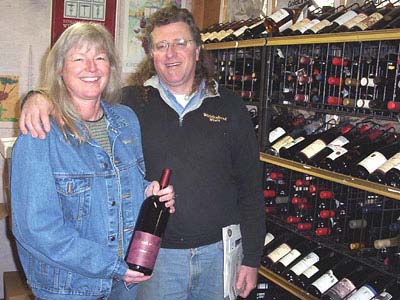
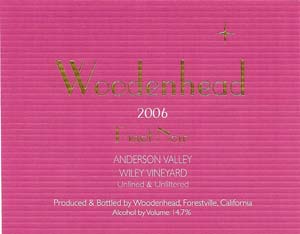 2006 Woodenhead Wiley Vineyard Anderson Valley Pinot Noir 14.7% alc., 358 cases, $60. When I tasted this almost a year ago, it was impenetrable and brooding. It has now opened up. · Medium ruby color. Flashy and expressive aromas of cherries and raspberries. Mouth filling richness with oodles of raspberry fruit, some Asian spice, and a long, chewy and aromatic finish. Really lovely wine with deft use of oak and impeccable balance. Expensive, yes, but worth it if you want the full experience.
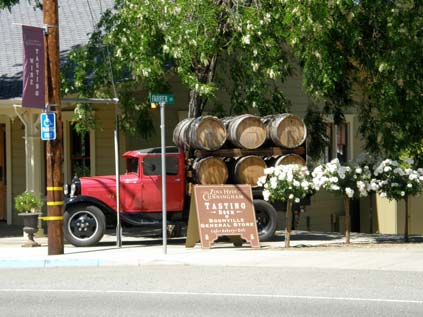 Zina Hyde Cunningham The Cunningham family history in Mendocino County dates to 1865 when Zina Hyde bought property in Ukiah and crafted excellent wines. Bill Cunningham, Zina’s great grandson, encouraged by cousin Steve Ledson, owner of Ledson Winery & Vineyards in Kenwood, started Zina Hyde Cunningham in 2004 in Boonville. The quaint Zina Hyde Cunningham Winery and General Store is located in downtown Boonville at 14077 Highway 128 across the street from the Boonville Hotel. It is open daily from 10:00 to 5:00. The wines (several varieties are produced) are sold through a mailing list and at the tasting room. The website is www.zinawinery.com. I have found the wines to be quite charming and well-crafted.
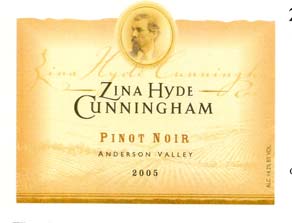 2005 Zina Hyde Cunningham Anderson Valley Pinot Noir 14.2% alc., 370 cases, $48. 3-5 day cold soak, hand punch downs and pump overs, 14-day cuvaison, wild yeast fermentation, aged 9 months in French oak barrels. · Moderately intense ruby color. Ornate aromas of black cherry pie, baking spices and toast. Middleweight cherry and berry flavors which veer to the ripe side. Caressing texture with imperceptible tannins and little evident oak on an elegant frame. An easy drinker.
 Other Anderson Valley Pinot Noirs worth a look: Adrian Fog Demuth Vineyard, Oppenlander Vineyard, Savoy Vineyard Pinot Noirs Artevino (Maple Creek) Tebbutt Vineyards Anderson Valley Pinot Noir Calstar Cellars Londer Estate Pinot Noir Domaine Saint Gregory (Graziano) Anderson Valley Pinot Noir Gryphon Anderson Valley Pinot Noir Lioco Klindt Vineyard Pinot Noir Madrigal Vineyards Anderson Valley Pinot Noir Mendocino Wine Company (Parducci) Anderson Valley Pinot Noir Radio-Coteau Savoy Vineyard Pinot Noir Whitcraft Morning Dew Ranch Pinot Noir Williams Selyem Ferrington Vineyard, Weir Vineyard Pinot Noirs
Spotlight on a Star in the Making: DrewOn a gorgeous Sunday morning following the Anderson Valley Pinot Noir Festival Grand Tasting, I drove the circuitous Philo Greenwood Road west from Philo. Dotted with towering redwoods and with little sign of life, I finally emerged 15 miles later into a clearing where an apple orchard was perched on a knoll with sweeping views of the countryside extending to the Pacific Ocean. I felt like the gates of heaven had opened and I had entered paradise. Jason and Molly Drew felt this way as well when they first came upon this property renowned for growing “Greenwood Gold” apples. In 2004, they had been searching the North coast for an appropriate location for vineyards and a winery and as fate would have it, this was the first property the real estate agent in Elk showed them. They moved in with their family (two boys) and lived in a trailer until the winery and their upstairs home was completed. As I viewed the orchard from the upper deck of the winery building, Jason pointed out the perfect exposures that are slated to be developed into vineyards. He spoke with reverence about the land and I could sense his heart-felt appreciation and gratefulness for his destiny in finding this special spot of earth. Located in the only incongruous appellation in California known as Mendocino Ridge, this newly discovered region just north of the Sonoma Coast just might be the next haven for California Pinot Noir. The photo below shows the future initial vineyard site in the distance and the shaded table where I sat down with Jason and talked.
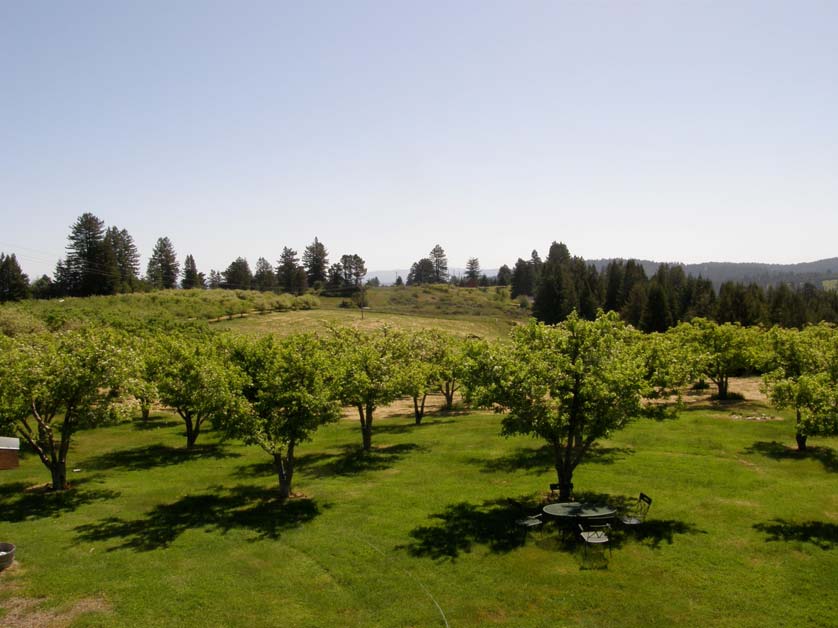
Jason Drew began his career in the wine industry in 1991 when he served an internship at St. Supery Winery
while at University California Santa Cruz. His first real job was at Carmenet Vineyards in 1992 through 1995.
In 1996 he became the vineyard manager at Navarro and was intrigued by the potential for winegrowing in the
Anderson Valley and the adjacent ridge tops. To pursue further training in enology he chose to go to University
of Adelaide in south Australia. His wife Molly was with him and his first son was born during finals week in
Australia. He returned to the states and began work as an assistant winemaker under Brian Babcock at
Babcock Vineyards in Santa Rita Hills in 1999. In 2000, he founded the Drew label and in 2003, left Babcock
to concentrate fill-time on his own label. Listen to the full story in my recorded interview: “Interview with Jason Drew”
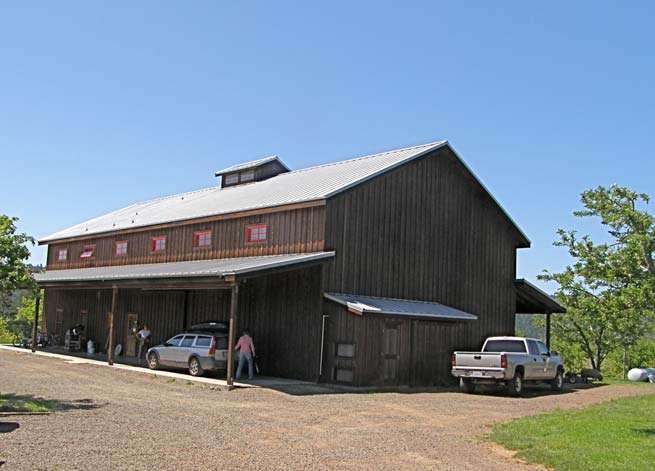
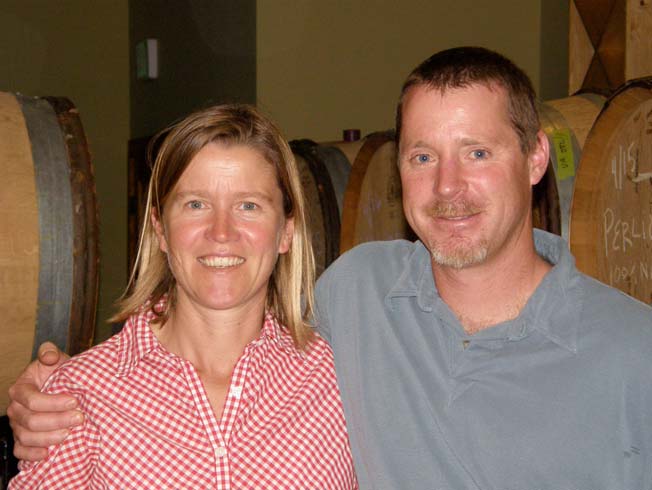 Since 2005, Jason’s wines have drawn my attention as well as many well-deserved accolades from the wine press. Last year, Drew was chosen as one of the Wineries of the Year by Wine & Spirits magazine. He is a gifted artisan producer of wine and drawing from grape sources as diverse as Sta. Rita Hills, Sonoma Coast and Anderson Valley, he consistently produces Pinot Noirs that show great purity of fruit, balance and structure to predict age ability. His wines are sold largely through an eager mailing list of devotees with limited retail distribution. I would recommend you join the list to obtain these limited production gems for this is a star in the making. I tasted through the entire 2007 lineup of six Drew Pinot Noirs. There will be no Savoy Vineyard bottling in 2008. Jason will be adding the Manchester Ridge Vineyard to his lineup in 2009. Jason also crafts cool climate Syrah from the Anderson Valley (Valenti Vineyard and Broken Leg Vineyard) and Manchester Ridge (Perli Vineyard Potato Patch). All the wines are sensibly priced ($40-$50) considering the quality of the vineyard sources and the impeccable winemaking.
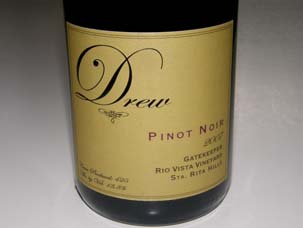 2007 Drew Gatekeeper Rio Vista Vineyard Sta. Rita Hills Pinot Noir 13.8% lc., 426 cases, $42. Sourced entirely from Rio Vista Vineyard located on the southeastern side of the Sta. Rita Hills AVA. Jason has worked with the same blocks from this vineyard since 2002. Average Brix at harvest 24.7º. Yields 2-3 tons per acre. Clones are 50% 777, 25% 667, and 25% 115. High density plantings dating to 1998. 10% whole cluster fermentation, 30% stem inclusion, 8-day cold soak, 21 days on skins. Aged 11 months in 30% new and 70% seasoned French oak barrels. · Expressive aromas of cherries, cedar, pine and mint. Delicious cherry and red plum with an appealing earthiness. Very smooth and elegant, nicely spiced, with soft tannins and a finish that lures you back for more.
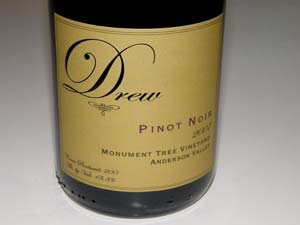 2007 Drew Monument Tree Anderson Valley Pinot Noir 13.8% alc., 200 cases, $42. This vineyard is located in the deep-end of the Anderson Valley in Philo. 15 acres planted to Dijon clones 114, 115 and 667 in 1999. Charles McBride is the owner. Yields were 2.4 tons per acre. Brix at harvest was 24.5º. 15% whole cluster fermentation, 30% stem inclusion, 7-day cold soak and 20 days on skins. Aged for 11 months in 30% new and 70% seasoned French oak barrels. · Moderately deep reddish-purple color. On the nose there are slightly confected red plums and berries, forest pine and cedar with a hint of camphor and spice, becoming more floral with time in the glass. Woodsy and earthy red berry fruit with a supporting dusting of oak. Beautifully composed with fine tannins, a spark of acidity and a soft and clean finish. Builds in momentum in the glass and keeps getting better and better. Like a well-perfumed and adorned debutante, this wine is a charmer. Tasted twice with consistent results.
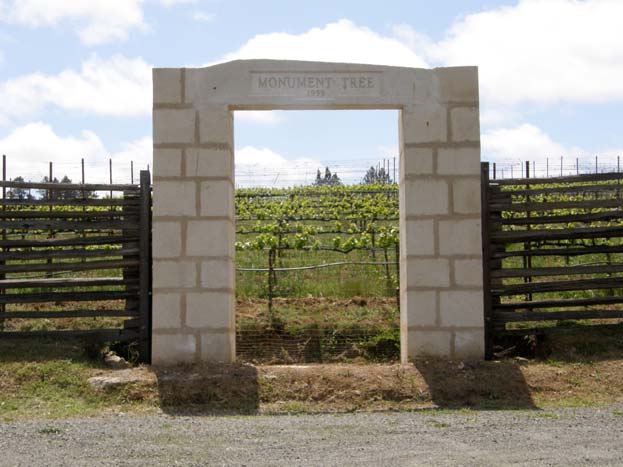
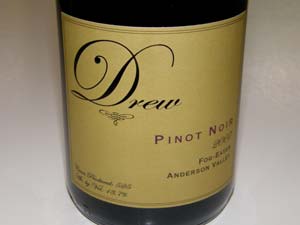 2007 Drew Fog-Eater Anderson Valley Pinot Noir 13.7% alc., 495 cases, $42. Fog-eater is a regional boontling term used by the early settlers of the Anderson Valley to denote a coastal dweller or someone living out on the margin. 60% Balo Vineyard (Dijon clone 828 and Martini selection) and 40% Valenti Vineyard (Dijon clone 667). Yields were 1.25-1.95 tons per acre. Brix at harvest 23.5º-24.2º. 15% whole cluster, 20% stem retention, 8-day cold soak, gravity racked twice, aged for 11 months in 30% new and 70% seasoned French oak barrels. · Expressive and enticing aromas of black cherries, cedar and forest floor.This wine speaks of its forested terroir with cherry fruit flavors enhanced with wooded forest and juniper berry flavors, moderate tannins and lively acidity. Still outgoing the next day from a previously opened and recorked bottle signifying age ability.
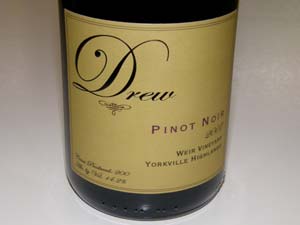 2007 Drew Weir Vineyard Yorkville Highlands Pinot Noir 14.2% alc., 200 cases, $42. This vineyard sits in a cool pocket among the redwoods at the southeastern border of the Anderson Valley. Situated on a steep southeastern slope at 850 feet, the soils consist of shale and clay. The vineyard was planted in 1992-1998 and is about 15 acres in size and contains rare heritage clones of Pinot Noir. For this bottling, four clones were combined: 2A, Pommard 4, DRC selection and Rochioli Riverblock selection planted in 1992. The owner, Bill Weir, is a Burgundy fanatic and has strived to produce old world character in his north coast vineyard. I have had some stunning Pinot Noirs from this vineyard! Yields were 1.88 tons per acre. Average Brix at harvest 24.2º. 15% stem inclusion, 4-day cold soak, 15 days on skins. Aged 11 months in 30% new and 70% seasoned French oak barrels. · A complete wine of great interest beginning with scents of dark fruits, cedar and middle eastern spices. Dark plums and berries assault the palate with intensity. A big-boned bruiser but not jammy. Flamboyant tannins balanced nicely with tangy acidity. The black knight in the lineup that Jason has managed to corral. Needs short ribs. Drank perfectly fine the next day from a previously opened re-corked bottle indicating a long life ahead for this wine.
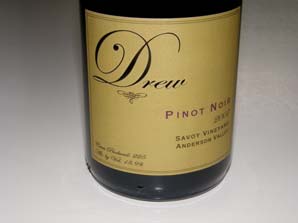 2007 Drew Savoy Vineyard Anderson Valley Pinot Noir 13.9% alc., 225 cases, $45. This meticulously farmed vineyard is located in the cooler reaches of the Anderson Valley near the town of Philo. Planted in 1992-1998, the clones are Pommard, Calera, and Dijon 113, 114, and 115. Yields were 1-1.8 tons per acre. Brix at harvest was 24.5º. 30% whole cluster fermentation, 30% stem inclusion, 7-day cold soak, 14 days on skins, aging for 11 months in 30% new and 70% seasoned French oak barrels. · Rather shy nose exhibiting aromas of red fruits, wet stone, minerals, wood and spearmint. Light and restrained for a Savoy Vineyard Pinot Noir, with pleasant cherry, cranberry and strawberry flavors. Notable tannin and brisk acidity. Decent but not a revelation.
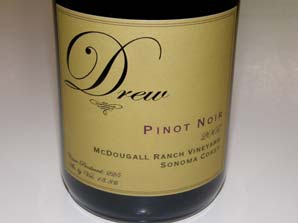 2007 Drew McDougall Ranch Vineyard Sonoma Coast Pinot Noir 13.8% alc., 225 cases, $50. From a small 7-acre vineyard planted to clone 114 in 1998 in a highly coveted area known as the “golden triangle.” It sits on a small bench 1,300 feet elevation about 2.5 miles from the Pacific Ocean on a steep south slope in the true Sonoma Coast. Brix at harvest 24.5º. Yields 2.1 tons per acre. 20% stem inclusion, 8-day cold soak, 18 days on skins, aged 11 months in 30% new and 70% seasoned French oak barrels. · The seductive nose sports bright fresh berries, cardamon spice, violets and Chanel #5. Sweet red fruits saturate the palate with a faint touch of oak. A comforting drink that is smooth and ethereal in the mouth with everything singing in harmony. Still great the next day. Full-on seduction.
An aerial photo of McDougall Ranch Vineyard below (small vineyard just right of center).
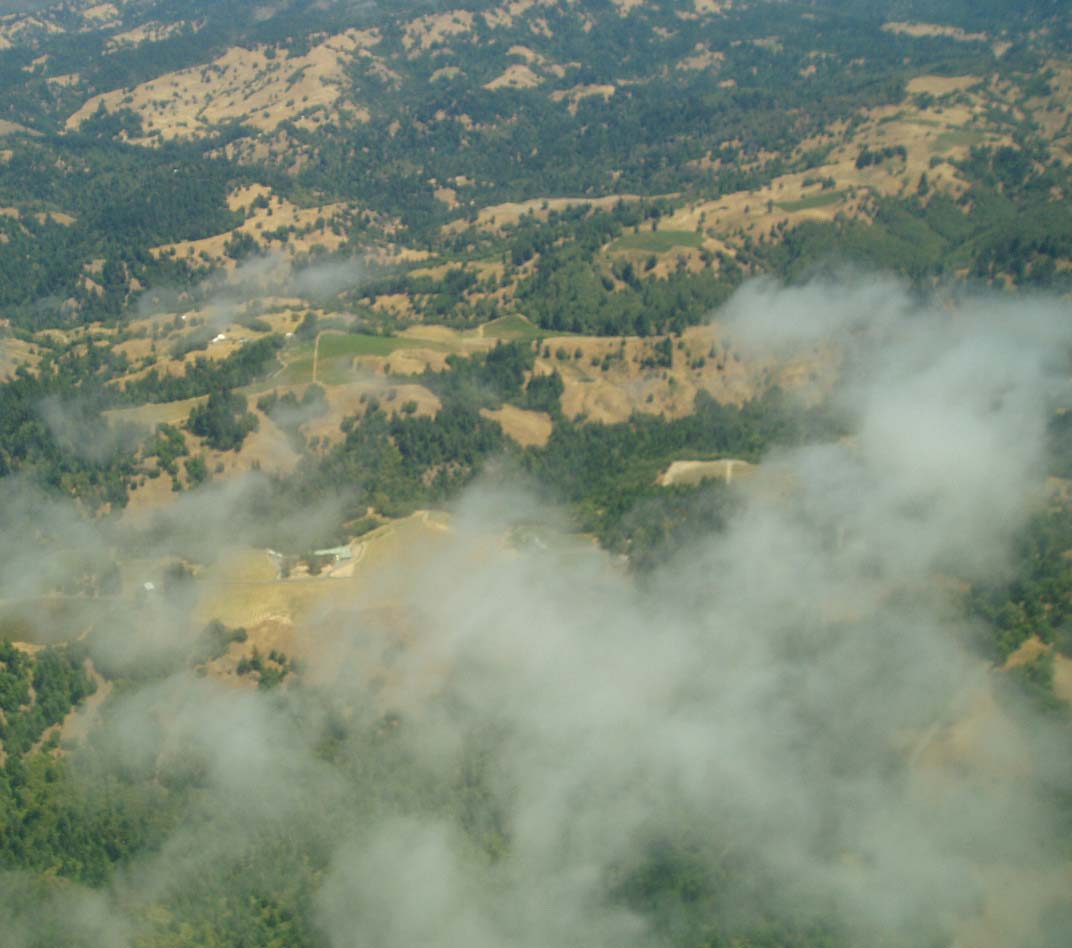
Rhys Vineyards Stakes a Claim in Anderson ValleyKevin Harvey of Rhys Vineyards believes that the best sites for California Pinot Noir have yet to be discovered and this drives him to plant new vineyards. His experience with planting in the Santa Cruz Mountains has given him insight into the site characteristics most expressive of Pinot Noir. He is firm believer that the common factor contributing to ideal terroir for Pinot Noir vineyards is shallow soil over fractured rock combined with a cool climate. There are only a handful of sites in California that offer this ideal scenario. Plantings of Pinot Noir in the most northwestern or deep-end of the Anderson Valley have shown impressive potential. According to Harvey, this area “meets all of our most important vineyard criteria.” He outlined these criteria recently:
• Shallow soils. This naturally aids vine balance, limits vigor and is critical for producing ripe fruit with low alcohol. • Deeply fractured and rocky subsoil. This allows vine roots to penetrate deeply but still struggle. It is key for wines that exhibit natural complexity. • Steep non-forested slopes. The slopes offer the perfect soil profile. Non-forested grasslands have the low fertility and soil chemistry that is optimal for wine quality. • Iron-rich soils. Pinot Noirs that exhibit minerality are usually found on soils with high iron content. • Moderate clay content and limited water holding capacity. Preferably a clay content of 25% or less. • Cool climate. A wide range of climatic conditions can produce great Pinot Noir but the coolest sites produce crunchy red fruit that is highly desirable. The Rhys-owned Bearwallow Vineyard is named after the Bearwallow-Wolfey series of soil that dominates the property. This vineyard already has 7 acres of 9-year-old vines that are in production. These blocks have always been farmed organically. The new plantings will have a better choice of spacing, clones and rootstocks. While waiting for the new blocks to come into production, Rhys will be making Pinot Noir from the existing vines. 2008 will be the inaugural vintage for Bearwallow Vineyard. Harvey has chosen to plant his Bearwallow Vineyard on steep slopes with grades of 20-40%. These areas are more expensive to plant and farm but he believes will make the most complex and balanced wine. There are at least 20 acres of potential upper slope vineyard with desirable characteristics. Alfalfa will be farmed organically on the lower portions of the site. Vine densities will be both 2300 (tractor farmed) and 7000 (hand farmed) vines per acre. Most of the blocks will be planted with what the French call “selection massale,” a diverse mixture of vines. Harvey believes that diversity creates wines with more complexity than more typical monoclonal plantings. A few acres will be devoted to Chardonnay as well, an unlikely suitor in this climate. Rhys Vineyards continues to be at the vanguard of cool-climate viticulture in California. Even though they have yet to release wine from all of their existing vineyards in the Santa Cruz Mountains, the few wines that have reached consumer’s hands have been met with awe. Rhys Vineyards is a well-researched and well-funded work in progress that holds promise for astonishingly good wines that can rival any currently in production in California. Keep up to date at www.rhysvineyards.com.
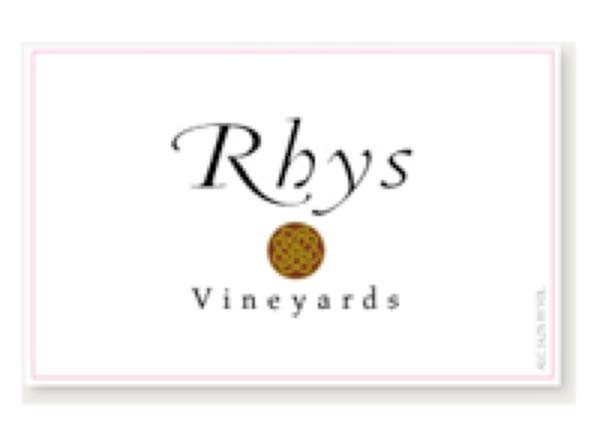
Pinot BriefsA Sign of the Times High-end Pinot Noir producers, Loring Wine Company and Pali Wine Company, who share a winery in Lompoc, have released appellation wines with the 2008 vintage to compliment their series of vineyard-designate wines. Part of the reason is the growing season in 2008 produced marked variation in quality within vineyards and part of the reason is that at this time the cash-strapped consumer deserves some less expensive but good Pinot Noir from respected producers. Loring Wine Company has released a Russian River Valley Pinot Noir and a Central Coast Pinot Noir priced at $24 a bottle (retail is $33) for mailing list members when purchased by the case ($288) including shipping. The two appellation bottlings may be mixed (6 bottles of each). Pali Wine Company (whose winemaker is also Brian Loring) will also be releasing appellation wines for the first time. The wines may be tasted Thursday through Saturday 11:00 to 4:00 and Monday through Wednesday by appointment. 818-681-4803 (Loring). San Francisco Restaurants Contribute to Northern California Wines Each day, the scraps from San Francisco’s most famous restaurants are sent to a compost facility in Vacaville in Northern California owned by Recology. The food scraps are transformed into rich, brown compost that is then used in some of the most recognized vineyards in Napa and Sonoma. Also, the compost spread in the vineyard helps ground cover to thrive which in turn fights global warming. American Drinking Habits According to the latest Harris Poll®, 56% of women drink domestic wine compared to 43% of men. On the other hand, 31% of men drink foreign wine versus 26% of women. Men are more likely to drink alcohol at least once at week than women (40% versus 19%) and more Millenials (those aged 18-32) drink at least once a week than Gen Xers (those aged 33-44). Democrats and independents are more likely to drink once a week than Republicans. Lightweight Wine Bottles Boisset Family Estates, in partnership with JW Marriott Hotels, has launched Fog Mountain, the first California wine in 1-liter PET (polyethylene) plastic bottles by EnVino Bottles. The first wine will be a Merlot sourced from several growing areas within California. Boisset is a world leader in PET wine bottle packaging. They shipped their entire 2008 Beaujolais Nouveau in PET bottles and bottled the first AOC wines from the Côtes du Rhone in the lightweight bottle style. The advantage to the PET bottles is reduced shipping weight, less energy consumed in transit and production and less carbon footprint of every case shipped. The bottles are recyclable, shatterproof, closed with a screw cap and do not impact wine quality. Australia is becoming a large producer of lightweight glas wine bottles. Glass container giant OI is producing bottles that weight between 18 and 28% less than conventional bottles. I love to see this trend. Ethics of Wine Writers Questioned Although Robert Parker,Jr. has historically maintained a strict code of ethics for the Wine Advocate, the integrity of some of the writers for this wine journal has been recently called into question. Reportedly, writers from the Wine Advocate have had travel expenses paid in recent years by trade and industry groups as well as partaken in lavish wine dinners and vacations fronted by wine importers whose wines are reviewed in the Wine Advocate. Robert Parker,Jr. has not been implicated and he claims no bias has occurred. To clarify my situation on this matter, I have never received payment for travel, lodging, and meals from any winery I have visited. I have on occasion received courtesy lodging at wineries with guest houses when attending Pinot Noir related events or traveling to report on wine regions. I have been hosted at a few winemaker dinners that were sponsored by public relation firms hired by wineries. Finally, I have had expenses paid to attend major Pinot Noir Festivals as media (Salud and IPNC in Oregon, for example). In the vast majority of trips, I pay my own way. I also continue to purchase a majority of the wines I review but do accept samples. I take purposeful integrity very seriously and strive at all costs to retain my reader’s trust.
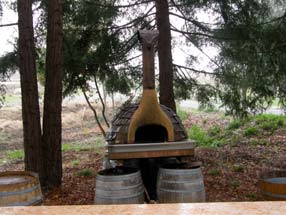 Lynmar Estate Pinot & Pizza Saturdays Hand-crafted artisan pizzas prepared with native winery yeasts, home-cooked marinara and pesto sauces from estate-grown heirloom tomatoes and ten varieties of basil. Vegetables, herbs and edible flowers are plucked from Lynmar’s estate gardens. Local artisan cheeses and meats are used. The pizzas are assembled by resident Chef Sandra Simile and cooked outdoors in a wood-burning oven. The pizzas are paired with Lynmar Estate limited-release Pinot Noirs. Future dates include June 13, July 11, August 1, and September 12 from 4:30 to 6:30. Price is $55 ($40 for Advocates Club Members). 707-829-3374.
 Oregon Certified Sustainable Wine Program In keeping with the spirit of Earth Day, the Oregon Sustainable Wine (OCSW) program was launched at www.ocsw.org on April 22, 2009. The site is part of a movement to help consumers understand sustainable farming and winemaking, from vine to bottle. Green minded consumers who are looking to put their dollars towards supporting their ideals will find the site useful for finding OCSW wines and learning more about the program and the wineries involved.
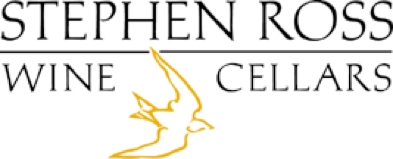 Stephen Ross Wine Cellars Relocates Stephen Ross, an accomplished producer of Central Coast vineyard-designated Pinot Noir, relocated their business in 2008 to San Luis Obispo and opened their tasting room on Labor Day. Tours of the winery with tasting is offered by appointment and hosted by either Stephen or Paula Dooley on weekends with special releases often available. The tasting room is open weekends at 178 Suburban Road, San Luis Obispo. 805-594-1318. Check out their unique Barrel Adopters program. Wine Preserva This is a simple way to preserve wine. A patented disc is inserted into an open bottle and acts as a barrier against oxidation by floating on the surface of the wine. The producers claim it preserves the aromas and tastes of wine for up to five days. The disc is made from FDA approved food grade material and is recyclable. Six packs sell for $5.99. Wine Preserva can be ordered at www.winehardware.com. I have not used this preservation method so cannot comment on its effectiveness but logically it makes sense. I personally have found pouring left over wine into a half bottle and sealing the half bottle with a used cork works quite well overnight. White wines can be placed in the refrigerator to retard oxidation and they will last a few days. 2009 West Coast Wine Competition The 27th event was held April 22-24, 2009 at Sonoma Mountain Village in Rohnert Park. The competition is produced by Vineyard & Winery Management. The Sweepstakes Red Table Wine was the 2007 Paradise Ridge Winery Russian River Valley Pinot Noir ($35), the Sweepstakes Rosé Wine was the 2008 Fleur De California Vin Gris of Pinot Noir North Coast ($13), the Sweepstakes Sparkling Wine was the 2001 Gloria Ferrar Caves & Vineyards Royal Cuvee Los Carneros ($35) and the Sweepstakes White Table Wine was the 2008 Ventana Vineyards Arroyo Seco Pinot Gris ($18). The complete results are available at www.vwm-online.com. In these competitions I only look at Sweepstakes and Double Gold winners since they represent a consensus of the judging panel and hold more weight.
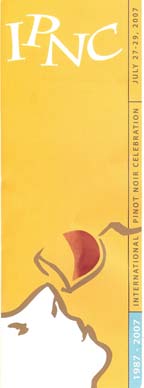 IPNC I was honored to be one of the invited media for this year’s International Pinot Noir Celebration in McMinnville, Oregon. Joining me are a number of outstanding journalists, writers and bloggers including Allen Meadows, John Haeger, Alder Yarrow, David Schildknecht and Jancis Robinson. The 23rd Annual event will be held July 24-26, 2009. Tickets are still available but not for long (www.ipnc.org). Attendance is limited to 700 people. ¡Salud! The Oregon Annual Wine Auction will host a benefit dinner featuring Jancis Robinson, the 2009 IPNC Master of Ceremonies. On Thursday, July 23, the pre-IPNC dinner will be held on Linfield College’s picturesque Withnell Commons lawn. Wines poured will be by Alma Rosa Winery & Vineyards, Elk Cove Vineyards, Fougeray de Beauclair and Westrey Wine Company. The cuisine will be prepared by Chef Benjamin Parks of Ten 01. The event will also feature a silent auction of rare ¡Salud! Pinot Noir cuveés from past vintages. The 18th Annual ¡Salud! Oregon Pinot Noir Auction will be held on Friday and Saturday, November 13 and 14, 2009. Be the first to experience the incredible 2008 vintage Pinot Noirs from Oregon. Visit the website at www.saludauction.org or call 503-681-1850. Men Wine Drinkers Live Longer The Journal of Epidemiology and Community Health reported this month that men who consume light to moderate amounts of any type of alcohol daily gain 2.5 years of life expectancy compared to abstainers. They also have a reduced risk of death from coronary artery disease and other circulatory problems. The study was conducted in the Netherlands and followed 1,373 men for 40 years. 70% of all wine consumed was red suggesting what many other studies have implied, namely, it is the polyphenols in red wine that provide the protective effect on heart health. Confounding factors such as socioeconomic status, diet, and lifestyle were accounted for in the study eliminating their influence on the study’s findings.
The Mendocino Papers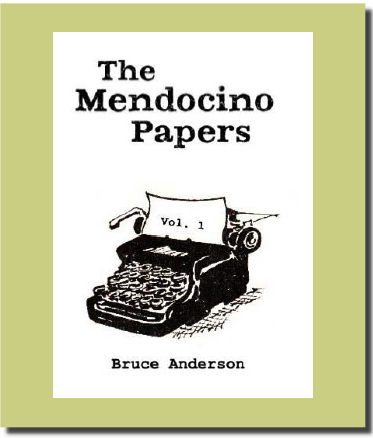 Bruce Anderson is the long time editor and publisher of Mendocino County’s Anderson Valley Advertiser. Volume 1 of The Mendocino Papers has been published and is the first in a series. Anderson’s anecdotal history of Mendocino County is mixed with colorful and humorous autobiographical memoirs beginning in 1970 when Anderson was part of the hippie generation who settled in the Anderson Valley. Anderson, who is not related to the original Anderson Family that first arrived in Anderson Valley in the 1800s, is a controversial figure in the Anderson Valley. He has been labeled a grump and has outraged local politicians and bureaucrats, but is an Anderson Valley original. This is not a wine book, but is a good read if you are interested in the history of the Mendocino region and some of its nefarious characters such as Charles Manson and Jim Jones. Available from the author for $20. Mail your order to AVA, Box 459, Boonville, CA 95415.
On the Pinot Trail in Anderson Valley
Anderson Valley Winegrowers Association: www.avwines.com
Lodging: Apple Farm is a 32-acre organic farm and apple orchard with a cooking school and three cottages run by Dan and Sally Schmitt, the original owners of the French Laundry (www.philoapplefarm.com). The Boonville Hotel is operated by the Schmitts’ son, Johnny, who doubles as the chef in the hotel’s excellent restaurant open on weekends for dinner (www.boonvillehotel.com). Anderson Valley Inn is an inexpensive rustic 7 room inn in Philo (www.avinn.com). If you opt to stay on the Mendocino Coast you will have a 45- minute drive through the redwoods to reach the Anderson Valley but the trip is quite scenic. Albion River Inn has deluxe accommodations overlooking the Pacific Ocean with a first-class restaurant (www.albionriverinn.com). The Rendezvous Inn & Restaurant in Fort Bragg is housed in a lovingly restored old home with a gourmet restaurant that offers superb dining on the Mendocino Coast (www.rendezvousinn.com). The Mendocino Hotel & Garden Suites is a historic inn overlooking the Pacific Ocean in downtown Mendocino with an excellent restaurant and wine list (www.mendocinohotel.com). The Elk Cove Inn in Elk is perched on a bluff overlooking the wind-swept ocean and is the quirkiest lodging you will ever experience (www.elkcoveinn.com) Restaurants: Boonville Hotel as described above. Libby’s has excellent Mexican food and is the locals’ favorite. Redwood Drive-In Cafe is a typical small town cafe. Mosswood Market Cafe & Bakery has very good sandwiches and wraps in Boonville. Lauren’s offers inexpensive dining in Boonville. Many of the wineries have scenic picnic spots. Pick up supplies at the markets in Philo or Boonville or the Mosswood Market Cafe & Bakery. On the Mendocino Coast, beyond the mentions under lodging, other good choices are Cafe Beaujolais, Ledford House, MacCallum House Restaurant, Stevenswood Restaurant and The Ravens at the Stanford Inn by the Sea. Winesong! is the premier Mendocino Coast Celebration of wine, food, art and giving. The annual wine and food tasting and charity auction on the Mendocino Coast is September 11-12, 2009. Visit www.winesong.org. |